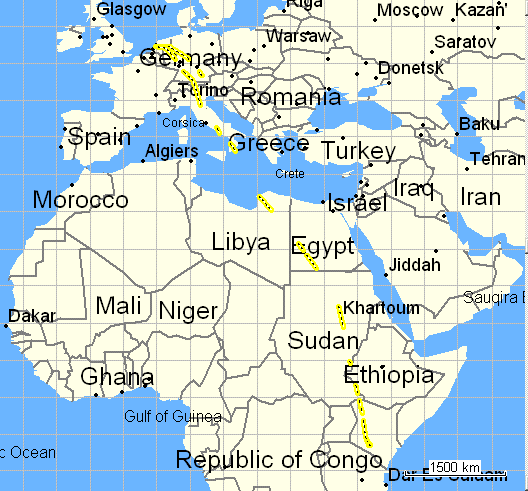
Private homepage – Hans-Georg Michna
Kenya travel reports: 1999, 2000, 2002, 2003, 2004, 2005, 2006, 2007, 2008, 2009, 2010, 2011, 2012, 2013-Goma, 2013, 2014, 2015, 2016, 2017, 2018, 2019
Kenya Safari Travel Plan, Kenya 1980-2000 photos
Kenya 2002
HANS-GEORG MICHNA
A personal travel report from Kenya in June 2002
Please click on the small pictures to see the full-size pictures.
|
Last change: 2004-05-24 – Copyright © 2002-2023 Hans-Georg Michna
A few readers had the problem that after clicking on a picture, then going back to the main page, all thumbnail pictures were reloaded. This is typically caused by Internet Explorer cache corruption. It can often be repaired by going to the Internet options and deleting the temporary Internet files.
All photos are subject to copyright ©. If you want to reuse any photo, send me an email asking for permission, and I can send you the full-size photo, usually 1,600 x 1,200 pixels. Photos bear the copyright © 2002-2023 Hans-Georg Michna.
Warning: This report contains photographs that may not be suitable for children, even though they actually show a child.
I wrote this little real-time travel report after finding out that the Internet is making inroads in Kenya, and I could upload the chapters soon after I had written them.
The majority of the photographs are now in, but two films are still not processed. One is still in my camera. The other appears to be lost for good by the lab.
The biggest photographs in this report are low resolutions scans, 768 pixels wide, so while reading it you may want to enlarge your browser to full screen size for full size and full quality viewing. Higher resolution scans and the original slides are available, subject to approval by the people on those pictures. I guess that some of these people would gladly sell the rights to their photographs.
For reasons of privacy and protection the non-indigenous and some of the indigenous names (like the camp workers) are abbreviated or not used at all. Some indigenous names are used, particularly those that are already used elsewhere on the Web, but only the first names. If anybody prefers to have his full name inserted here or even his first name removed or the story otherwise changed, please drop me an email, and I'll gladly comply.
Woke up at 4 am, stuffed the last few things into my luggage, then my wife drove me to the airport at 4:45. We arrived at 5:15, 1½ hours before departure of my flight to Amsterdam Schiphol. The flight was uneventful. I had a window seat and could record the flight on my little GPS receiver (Garmin eMap) and see where I flew.

In Amsterdam I had some time left over until the departure of the long flight at 11 am, so I went to an Internet café, purchased a code worth 15 minutes online, and tried to plug in my computer.
That didn't work (Ethernet socket dead), so I began to look for the company's central office on the airport, which I found after asking the right people.
The man there told me that, indeed, those sockets weren't wired yet, but he could give me a connection here. So he did, and that's how the first emails went out.
The long flight at first seemed to begin nicely, however, one woman didn't show up, but her suitcases were already stowed in the big belly of the MD-11 long range airplane. Thus the flight left about 1 hour 15 minutes late. Only the favorable winds allowed us to recover much of that delay, and we were to land only half an hour late.
The flight this time went straight down Italy, across the Mediterranean to Benghazi, over endless sand desert, cutting through a corner of Egypt, then into Sudan, overhead Khartoum, and on through southwestern Ethiopia into Kenya on the usual route via Lodwar, Baringo, Nakuru, Naivasha to Nairobi.
When we reached Kenya, it was already dark. Only the GPS showed me where we were. There was no complaint from the cabin crew, by the way. KLM appears to allow GPS use during cruise flight.
In Nairobi I walked out of the plane, this time through a finger directly into the central building. I wasn't quite sure whether I would need a visa or not. There was once a rule that you needed one only above 30 days, and I was going to stay for 29½ days, or for 31, if each partial day would be counted as a full one, but it turned out that I had simply forgotten that the rules had changed again and nearly everybody needs a visa now, regardless of the time of stay.
So I was sent back from immigration to the visa counter, where a long line had meanwhile formed. This could take an hour, and with the time the risk rises that something happens to my luggage. Fortunately they opened a second counter and waved the latter part of the line over, with me second place. Sheer luck.
After paying $50 for the visa, I descended into the luggage hall where I found a crowd of people and lots of luggage circling on the conveyor belts. But the luggage from my flight turned out to be still not there, in spite of the visa delay.
So I walked past the three bank counters, looking for the best exchange rate to buy some Kenya Shillings (KSh). When I looked at the electronic exchange rate board in the third bank counter and was about to turn away because it was poor (around KSh 70 to the €), the man behind the counter waved me back and pulled a piece of paper, telling me that the board still shows old rates. Indeed the paper rates were better (around KSh 72 to the €), so I exchanged €300 and got something close to KSh 22,000. As the biggest bank note is KSh 1,000, even this amount is a thick bundle.
I raced back to the conveyor belt, but there was still no sign of my luggage. Eventually my sleeping bag turned up, as a sign for better things to come. I had marked all my luggage with a conspicuous wide black and yellow striped adhesive tape, partly so I can spot it better and partly to make it a bit more difficult and risky to steal. So far this has always worked or was unnecessary, who knows?
I left the customs area. The customs officers stood around but didn't actually check anybody while I looked. That's good, because some of the things in my luggage are certain to raise attention. They are actually harmless, but the normal customs officer might not immediately understand why I'm travelling with a bundle of detailed flying maps for Kenya, issued by the US Department of Defense. In fact these maps are freely available, even in Kenya, but it may take some time to convince a customs officer of that.
I went to the Hertz counter to collect the key for my jeep. Somebody was there, the key was there, the guy kept my luggage, so I didn't have to walk across the dark parking area with a carriage full of luggage in the middle of the night. I asked him with raised eyebrows not ever to turn any of his eyes away from my luggage until I'd be back, and he complied.
I found the jeep, a Suzuki Sierra as planned, but this time white, rather than light green. I drove it around the building and stopped near the counter, loaded my luggage while being very attentive to my environment, and drove away.
The payment system has changed. Now you pull a ticket when you drive in and pay according to time when you drive out again. So no more speeding through the gates. One hour costs KSh 30, a whole day is KSh 150 for any normal passenger car. The ticked was already in the car, as somebody had driven it into the airport shortly before.
The first night drive on the left side of the road through the outskirts of Nairobi always fascinates me. At the same time I try to be fully aware of anything that could be a danger, so I am wide awake during this drive and take in the new environment with heightened sensibility.
Driving at night in most of Africa is not something one wants to do. While I stay here, I avoid it when possible. There are three reasons, crime, potholes and other cars. But when visiting somebody, I have no choice. At least the GPS makes sure I don't lose my way in the dark.
About 20 minutes later I arrive at the Aero Club (a private flying club, not open to the public). The gate of Wilson Airport had been unoccupied with only a few policemen hanging out in the dark, so I hadn't had to pay there and had driven right through.
The receptionist had already gone home, but the bar was still open with a few people hanging out there. The barman gave me the key to my small single room (#2 in the old wing, with shower, KSh 1,700 per night, very reasonable). These rooms now have TV! Deadly for me, as I lack the resistance of the ordinary TV viewer, but I'll manage. With only 4 channels the temptation is at least not very high. Things are getting better (or worse), it seems.
(Madaraka Day, a public holiday in Kenya)
I slept my first night, took my first shower, arranged my things, put the first film in the camera, mounted the GPS holder in the jeep, and am now sitting in the afternoon sun in the garden of the Aero Club of East Africa. Next to me is runway 07 of Wilson Airport on the eastern edge of Nairobi, surrounded by the outskirts of the city on two sides and Nairobi National Park on the other two. Which means that, if only I looked sharp enough, I could already see the lions, buffalos, giraffes and rhinos that make the east African savanna landscape even more remarkable than it would already be without them.
From here I can see a hundred miles. On particularly clear days I can see the peak of Kilimanjaro, some 100 miles from here.
A Cessna 152 Aerobat, a small aerobatics-capable two-seat trainer, is doing circuits (repetitive touch-and-go training flights). I had chatted with the instructor before he set off with his student. The economy is not doing very well, but the Aero Club survives nonetheless. One Cessna 152 was crashed in February, when somebody attempted unsuccessfully to take off uphill from the Safari Club airfield on the slope of Mt. Kenya, "landed" upside down, but survived. The plane is already being repaired.
I intend to take a few flying lessons on Tuesday to get back into shape on the Cessna 182 that I haven't flown for almost a year.
The other plane doing circuits is a Cessna 182, and from time to time a twin engine plane lands or takes off, usually with tourists or UN personnel on board. Part of the biggest and most famous nature reserve in Kenya, Maasai Mara, the northernmost extension of the famous Serengeti in Tanzania, has been cut off by torrential rains that took out the only bridge. It can now only be reached by air.
It is 6 pm now. The sun is about to set, almost vertically, as I'm more or less on the equator, and after half an hour of dusk it will be pitch-dark. Already now it is getting cool. I wear a shirt, but brought a light jacket for the cool evenings.
Altitude at Wilson Airport is 5,535 ft, approximately 1,650 m above sea level. The sky has been blue for most of the day with a few scattered clouds. The blue may be a bit darker here because of the altitude and the thin and clean air.
Due to the Kenyan public holiday nearly everybody is at home and the club almost empty. A few people arrive now to have dinner here. Two children play on the club's playground.
I took my laptop along for the first time. I might as well get used to it, because this will be the last year I take photographs on film. My plans are to switch to digital soon. I think the better digital cameras are now close enough to film to be viable. I may even reduce my equipment, reduce my sharpness demands a bit, and switch to a camera with just one super-zoom lens. Earlier 1 : 10 zooms weren't good, but at least two of the newer ones are apparently as good as it gets, so there is hope that I can soon find a digital camera making use of this achievement.
I'm not sure when and where I'll be able to send this text, but there seems to be an Internet café right here at the airport. It's just closed until Monday.
Visited one of the Amboseli researchers (the pilot) and met more people there. It was very nice. I met and chatted with a couple of interesting people, was fed all too well, even got an Internet connection there, and drove back across Nairobi late at night without any problems.
A day with a whole lot of things to do. First I went to the doctor to undergo the the obligatory medical examination for the renewal of my flying license. I'm healthy, so no problems there. Had to wait for the doctor to arrive in his office until 9:30 am though. He apologized, but then I was still his first patient, so coming much earlier could have been a waste of time. Time goes differently in Africa, you know.
Then I went to the Director of Civil Aviation (DCA) to actually renew my license. This also went reasonably well. I can collect the new license tomorrow.
Then I went to Rasul's Car Hire & Tours (www.rasuls.com, a Web site I made for them) and spoke to Shahid Rasul, third generation I know of the family. He's a very nice guy. His grandfather, from whom I began renting cars many years ago, is ill and in hospital, so I couldn't exchange the customary welcome with him. Shahid is worried about his health.
They have new cars. Shahid had already told me about some new Maruti jeeps that are similar to the Suzuki Sierra I drive now, but have a stronger engine and better suspension. They are also slightly more expensive. I had stuck to what I knew and remained true to the Suzuki.
This time my Suzuki jeep is white, not green. I would slightly prefer green, so I'm less visible, but the car runs so nicely that I kept it, rather than swapping it for one of the green ones that I had driven so often before.
Finally I went back to the Internet café that I had finally discovered after some searching. It is just outside the Wilson Airport gate, a semi-dark room with a few desktop computers in some special wooden pieces of furniture that hold exactly one computer and one keyboard to save space.

The Internet café at Wilson Airport
But I wanted to connect my laptop. The service people (one per computer, it seemed to me) didn't know whether and how they could do this, so they sent me to the boss. He said OK, time would have to be taken manually. The price is 2 Kenya Shillings (KSh 2) per minute. KSh 72 are one €, so this was much cheaper than anything I had seen before, so I tried it.
They didn't know how to connect my laptop, so I looked around and saw a hub hanging from the wall. All ports were occupied, so I pulled the Ethernet cable from one of the computers and checked which light went out. I then pulled that cable from the hub and plugged in my own cable, because the existing one was too short to reach my laptop that was standing on some kind of bar stool in front of the desktop computer, whose small mouse pad I wanted to use.
Somewhat to my surprise it worked on the spot. They had DHCP, so no setup was necessary. That's why you can now read this page (after I go there again).
While I was checking email and news and uploading the previous version of this Web page, I noticed two computer speakers connected to a tiny radio, playing boring music. I asked them whether they would like to hear something different, and they agreed, with curiosity. So I fired up my AAC and MP3 player and selected some music I thought they would like, Titiyo, Atomic Kitten, the Aqua - Aquarium CD, then a couple of oldies. I pulled the plug from the radio and plugged it into my computer, which lead to a more party-like atmosphere. They definitely liked the music.
My problem then was that they turned the volume well up, which required a lot more concentration to write my emails, but I don't regret it. It's nice to be able to make people a little more happy.
Had a nice small breakfast in the Aero Club, then I set off for the DCA to collect my renewed pilot license. Everything went smoothly, and while driving along the 4 lane backbone road of Nairobi to and from the international airport, I observed and thought about the Kenyan driving style. My subjective impression was that the style has improved. Everybody seemed to drive relatively slowly, gently and thoughtfully. Most even used the indicator before changing lanes. I believe they come very close to the German (admittedly low) compliance level on this one. Haven't driven further along the 2 lane Mombasa road though and can only fear that the risky overtaking does still happen.
After coming back I stopped at the Internet café in front of Wilson Airport gate again and exchanged information for about 15 minutes. Then the connection broke, but I had already done almost all I wanted, so I disappeared and drove back to the Aero Club.
An hour later it was already time for the checkout flight with V., the Chief (or Certified, I'm not sure) Flying Instructor (CFI) of Pegasus Flyers, the flying branch of the Aero Club. I found the plane, a Cessna 182 with a 235 hp 6 cylinder engine and four seats, on the apron in front of the hangar, had the tanks filled, so the plane would be heavier and more similar to the normal full load of passengers, and did the preflight check. I then met V., and off we went.
The wind mandated the shorter runway 14, which also has a somewhat cramped circuit because of the president's house and garden that would be under a straight approach to runway 14, but it is prohibited, so one has to turn into final approach fairly close to the airfield. Final approach is low over the road to Langata that passes just in front of Wilson Airport on the northern side, so landing short or low is not what I want to do unless I want to scare the drivers or damage their car roofs.
We did a few touch and go landings, and I came in fairly high. The big landing flaps of the Cessna 182 make this possible, but apparently V. wanted to know what I'd do if I didn't have them, so he asked me for a flapless landing next. Of course, training flights are often done with simulated failures, because normal flying is too easy. Anyway, I could do that just as nicely, so he asked me to change over to runway 07 that had about a 10 knot (18 km/h) crosswind at the time. I could do that quite well too, so after two more touch and go landings we finished the checkout and taxied back to the Aero Club. He then said, "I must say, that was very good." I suppose he referred to the fact that I hadn't flown for almost a year, but could still do it. My impression is that my mental model of the flying plane is reasonably precise and complete, so I can handle all situations quite well. Nonetheless it is the humble pilot who lives longer, so I will not make myself believe that I'm above all things here.
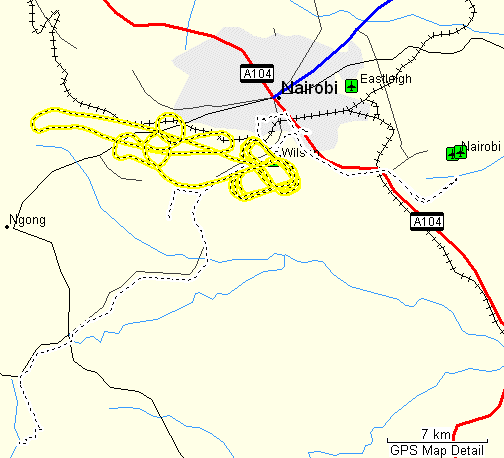
GPS track of 3. to 5. June – flying tracks are yellow, driving tracks are white.
The two repetitive ovals around wilson are the circuits on runways 14 and 07. The
figures to the left show the flight in the local area. The line to the lower left
is the car ride to the house in the Rift Valley.
The whole day has been sunny again from the early morning on. Now it's afternoon, and I'm sitting in the Aero Club's garden restaurant after a nice lunch, typing these lines. Temperatures do not quite reach 30°C (in the 80s, for the Fahrenheit readers) around noon, and in the later afternoon the thin, dry air is very pleasant under the sun umbrellas that protect each table.
Tomorrow will be a working day. I will have a meeting with the heads of the elephant project in the morning, the second check flight at 2 pm, then I will move out of the Aero Club's guest house and into the home of one of the elephant researchers outside Nairobi on the edge of the Rift Valley for an extended working session that will last for the rest of the week. Then the head of the project will come back from America, and more plans can be made. I already had someone deposit some cheese in her refrigerator that I brought from Germany to bring some additional variety into the Kenyan cheese landscape. Kenyan cheese isn't bad, but there aren't many different kinds, so some foreign cheese is always welcome for cheese lovers. Next year I might bring chocolate as well, but that needs to go into a fridge quickly in the tropics.
In the morning I had a meeting with some of the project people. We worked on the elephant database in a place called Langata Link. That's a small "business park", consisting of a parking place for about 20 cars and a ring of small bungalows in a garden-like setting with lawn and a tiny restaurant in the middle.
All bungalows have an Internet connection, one is a "cybercafé" with 5 computers linked to the Internet. The bungalows contain offices and are tidy, clean, and equipped with nice and functional furniture.
In the early afternoon I went back to the Aero Club to have a second flight with V. We flew away from Wilson airport and practiced stalls (flying too slowly, so the plane falls down). We also performed a simulated emergency landing, so I could test whether I can get exactly to the intended landing site without using the engine, which I did successfully. Just before actually landing, of course the engine is used again and we climbed out without actually touching the ground.
After that I drove back to Langata Link to meet up with the others again. One of the project leaders invited me to her home on the edge of the rift valley to do more work there, where it's quiet and beautiful. So we drove out on the road to Magadi (deep down in the Rift Valley) through Ongata Rongai, Kiserian, where her husband stopped to negotiate with a welder about erecting a new antenna on the house, then we continued through Oloisiusiu and up towards the edge of the Great Rift Valley.
At the highest spot, south of the Ngong Hills, we turned off Magadi Road and drove to the house, located on the steep western slope of a hill, overlooking the valley. Deep down below is a small river valley in front of another, lower ridge. Down there is also a spring from which the house gets pure, drinkable water.
The spacious house is entered over a flight of steps from above. It is elongated and stretches along the hillside. On the valley side there's a terrace below the window front of the house. There's also a lower floor with guest rooms, of which I occupied one, complete with bathroom and shower.
The house has a complex energy system, a combined solar and wind electrical supply, of which the wind generator supplies the majority of the energy.
There are no ordinary light bulbs in the house. All lighting comes from energy conserving florescent bulbs or from candles. There is a fridge and a freezer, however, possibly the biggest energy consumers in the house. A radio telephone link connects to the rest of the world. A satellite antenna feeds the television set.
We had a very nice chicken for dinner, then we went to bed fairly early, around 9:30 pm.
The days are filled with work on the elephant database, chatting, and enjoying the beautiful scenery. It is very quiet and peaceful here. Every day it strikes me as a miracle that one can be in this wild, primordial landscape on the edge of the Rift Valley and yet have the amenities of civilization in the house. OK, the Internet connection could be a bit faster and more reliable, but perhaps you can't have everything.
We're more than 2,000 m above sea level, and I notice it. Quite often I feel the need to take a deep breath. I once learned that it can take a week or two until the human body adapts, by producing more red blood cells. Full adaptation to high altitudes can take a month or more. But then Munich is already 600 m above sea level, and the days in Nairobi (1,600 m above sea level) also count, so I won't have any real problem with this.
The mobile phone doesn't work at all in the house, but when I walk just a few steps up towards the top of the hill, I can see Nairobi city and get a perfect connection (all bars shown).
The grass is still unusually green here after the rich rainfalls before my arrival, but now the dry season has clearly begun. I have not seen a single drop of rain since I arrived in Kenya.
In the morning the house is often in the clouds and the deep valley, perhaps even the entire Rift Valley, is filled with fog. When I look from my lower sleeping room over the terrace, it almost looks as if I were at the shore of an ocean. But by about 8 am the cloud dissolves and reveals the gorgeous 100 mile view across the Rift Valley from Lake Magadi to Mount Suswa, a big, broken-in volcano, and the Ngong Hills.

View to the Ngong Hills from the south—the Rift Valley is on the left (west) side,
Nairobi about 20 km to the right (east)
Success! We finished the biggest part of the database work. It was quite intensive, with two people, the researcher and me, working on the database more or less full-time.
We have now solved all the big looming problems of the database and cleaned up much of the smaller inconsistencies. There are a few bigger tasks still to do, but we're clearly over the hump. A bottle of wine was opened to celebrate the event, and even I drank half a glass.
The day was cool, temperatures early in the morning were around 12°C, and I experienced the first rainshower during this stay in Kenya, a fine, drizzling rain that lasted only a couple of minutes. The rest of the day was a mixture of clouds and sun, temperatures a bit lower than in the days before. I wore a light jacket all day. But then we're high up here, so this should be no surprise.
We found a few more problems in the database and solved them on the spot. It seems we're through with all the major design and cleanup work.
The day was again relatively cool. In the morning there was a high cumulostratus with the sun shining through, but during the day it stayed mostly cloudy. Only in the late afternoon did the sun break through, and I took some photos of the western terrace and valley side of the marvellous house I have stayed in and that I will soon leave to move to other places.
Fresh data from the field (from Amboseli) had to be appended to the database, which was a bit difficult, because I had already changed the structure of the central database, but it's done now.
I'm spending one last night in the house at the edge of the Rift Valley tonight.
This is my last drive from the wonderful Rift Valley house to Nairobi. After a light breakfast with toast and jam I jumped in the car, not long after sunrise. The area was cloudy. All windows of the car were wet—I had to use the windshield wipers to see something.
I slowly wound my way through the narrow track, often only in pedestrian speed because of the rocky and sometimes steep car track. One of the two gates that I had to pass was still closed, so I had to jump out of the car, open the gate, drive through, jump out of the car and close the gate again.
After the long, winding car track I eventually reached the Magadi Road and continued towards small villages with exotic Maasai names, such as the already mentioned Oloisiusiu and Kiserian. In the mornings many people are on the road, walking to their workplaces or standing at bus stops waiting for the next bus or matatu (private shared taxi, usually minibuses). I usually enjoy these drives because of their many impressions. There are the schoolchildren with their school uniforms, the matatu conductors knocking on the metal of their minibuses to attract passengers, the often phantastic paintings and writings on the walls of the small shops. Some of these people are very slim, perhaps inheritance, perhaps due to malnutrition, undernutrition or disease ("slim disease" is a euphemism for AIDS here), but some are just stunningly beautiful.
The road falls into small river valleys and climbs out of them again, such that I sometimes have to switch back to second gear in the Suzuki. The matatus in front of me then spit out a black cloud, if it's a diesel engine, or a blue cloud (of oil) if it's petrol driven. The worst is a truck in front of me, for which one half of the road is too narrow, so it drives hard at the left edge, sometimes off the road, throwing up clouds of dust.
Suddenly I see a man lying on the road. I stop in front of him to make sure whether I can do anything to help. Looking more closely, I see that his head is too narrow, the skull squeezed, a bit of his brain coming out of his crushed forehead, his legs in an unnatural position, they are broken. The man is dead, at least one light car must have rolled over him shortly before I arrived at the scene. There is nothing I can do. About 25 people have gathered and look at the corpse with sad expressions in their faces.
I ponder the thought of taking a photo, but there are limits even to my incessant intention to take photos of each and everything. Slowly I drive over into the right lane and leave the sorry scene.
Actually this is the first time I have ever witnessed a road death in Kenya after spending a total of several years there. Though the statistics are depressing, it is not as common as to see it repeatedly if you don't live and drive there all the time. But the sight doesn't leave my imagination, the memory is still haunting me.
I arrive at Wilson Airport and wait for the pilot who arrives a short time later after a call to my mobile phone to let me know of his traffic-related delay.
At 10:30 am we depart from Wilson Airport to Amboseli with one of the researchers at the controls of a Piper Cherokee PA-235 (single engine, 235 hp). I sit in the right seat taking photos from the air. Over Amboseli we see quite a few elephants in and around the swamp.

Elephants in the swamp, viewed from the airplane

The research camp, viewed from the airplane
In Amboseli I installed the new database in the Ol Tukai Research House, then we go on to the research camp in the bushes named Ol Tukai Orok in Maasai language.
I'm sitting in the tent in the research camp now. It is 7:30 pm and the nearby lions just gave off their first call. There are two lions shouting at each other. They call to avoid accidentally meeting each other, which could result in fight, injury and possible death.
My tent is farthest from the rest of the camp, so I have to worry a bit about wild animals when I walk to and from the tent at night. Actually it is not the lions that warrant most of the worries, but the two male buffalos that regularly use the camp at night. One night they almost killed a Maasai night watchman, and one night one of them decided to eat directly in front of my tent window, keeping me awake for much of that night.
In the morning the researchers drive out to find Willa, a 44 year-old elephant cow, the matriarch of her family group, who is seriously sick. I accompanied them to document the entire episode with the camera.
After a while we find Willa in the same place where the researchers had left her the day before. She hardly moves, and when she does, she avoids using her right foreleg, which is swollen, especially higher up. The swelling even includes her right teat.
As planned and coordinated by radio, at about the same time a ranger jeep arrives with two veterinarians, a middle-aged man and a young woman, and a couple of rangers. The vets come over to our jeep, because all elephants in Amboseli know it very well and tolerate its presence very close to them.
We drive towards Willa and inspect her from all sides. She stands still and hardly moves. She is not afraid of the jeep at all and allows us to look at her swollen leg from a distance of about 10 m.
The vet says that it's difficult to determine the nature of the disease. There is no visible wound. The swelling is higher up, so a snake bite is not very likely. No bone is broken, otherwise she wouldn't be able to use the leg at all.
He decides to treat her nonetheless and give her antibiotics, some anti-inflammatory drug and the like. He readies his air pressure gun and prepares the dart with the correct dose of the extremely effective drug M99 that will immobilize her. From the same close distance he shoots the dart into her left rear side.
M99 is 10,000 times more potent than morphine. Just getting it on your skin can kill you. (See http://bigfive.jl.co.za/dart_accidents.htm for some details.)
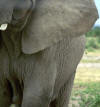
See the dart on the right side
She reacts instantly, raises her trunk, looks agitatedly at us, then turns around and walks away into a bushy area.
We follow in a wide distance, so as not to chase her or push her on. The female veterinarian keeps track of everything and begins to write a report on the whole operation. 4 minutes after the shot, the elephant begins to show first signs of dizziness. Her gait of the hind legs becomes more and more staggering until, after about 7 minutes, she falls on her side, unfortunately on her right side, so the diseased leg is at the bottom and more difficult to reach and inspect. Moreover, there is concern that she may not be able to stand up again on her own if she lies on her sick leg.
Immediately after she falls, we jump out of the jeep and go to her to see whether everything has gone well so far. She is fast asleep. The female vet puts a small stick in her trunk tip to keep it open and make sure that she can breathe. But it is decided that she needs to be pulled over to the other side.
Two ropes are tied around her legs, and everybody pulls to roll her around over her back. But it does not work. We are not strong enough to make it.
Meanwhile the male vet begins to give her several injections. An open wound in her back is treated, probably the consequence of another elephant tusking her. Elephants hate sick elephants and often attack them, unless they are directly related.
The elephant is measured. Shoulder height, size of feet, length, various other measures. Then the ranger jeep is used to pull her over. The two ropes from her forelegs and hind legs are pulled over her body and attached to the front bumper of the jeep. Then the jeep pulls backward, but even this does not work, as the rear wheels just turn in the sand without moving the car or the elephant. After going into low speed four wheel drive, the jeep finally manages to pull the legs over to the other side. Half way through the driver hesitates, and everybody shouts, "Go, go, keep going!" Just before the elephant could roll back, the driver continues to pull, and the elephant rolls over her back to the other side.
The ropes are removed, and the vet continues to give the elephant a whole sequence of injections in various body parts while his colleague keeps writing down the details and measuring fever in the elephant's anus. Somebody else pours water over her head and ears to cool her. The elephant is even milked to relieve her of some milk that she could no longer give to her youngest calf that went away with the rest of her family group, but the calf, at 4 years, would probably survive easily even if the treatment should fail and the elephant die.
After all medical injections have been given, the vet starts the final phase by injecting the antidote to the immobilizer, called M5050, into an ear vein.
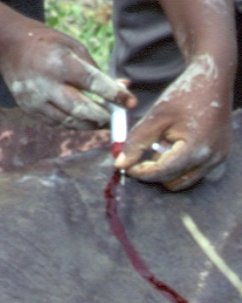
Waking her up with an M5050 injection into an ear vein
"How long does it take until the elephant wakes up?" somebody asks. The answer is, "One to two minutes." Hearing this, I jump back from between the legs of the elephant, and everybody moves quickly to the jeeps.
Indeed the elephant wakes up very quickly and almost immediately stands up, even while the last people are still boarding the jeeps. We close the doors and watch the elephant. She turns around, looks at us once more, then walks away. The short-term effect of her treatment appears to be quite positive, but this says little about the final effectiveness of the treatment, which we will learn only days, weeks or months later.
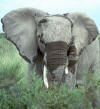
Willa is still wet from the water poured over her head and ears
The episode spanned three of my films (about 80 photos) and required me to change and use all of my lenses in quick succession. [One of these films went missing in the lab, unfortunately.]
We drive back to the research camp chatting about the whole operation and about our plans for the next days. We decide to change the plan at short notice. The carpenter who had come with us to build a new wooden water tank tower made good progress, but hasn't finished his work yet. The new plan is that the pilot flies back to Nairobi now and will collect both of us Friday morning.
In the afternoon I take the pilot to his plane, only to see that hyenas have bitten off the right rear end of the horizontal stabilizer cowling. We discuss whether it might make sense to cover the gaping hole with duct tape, and he does it, leaving us wondering whether the duct tape will still be there after his landing in Nairobi. We decide that he take off and check for any worrisome vibrations. If none, he would continue to Nairobi, otherwise he would fly one circuit and land again.
So I stay at Amboseli airfield and watch the plane disappear in the grey, overcast sky. It does not return, so I can safely assume that nothing really worrying has happened and that the damaged plane will make it to Nairobi safely.
On my way back with the jeep I run into a pride of lions blocking my way around the Ol Tukia Orok bushes and into the research camp. So I stay with them for a while, until I hear the others talk over the radio about where I might have got lost. I reply briefly and continue into the camp.
In the evening the remaining researchers meet, as usual, in the dinner tent, and we have a nice conversation and a tasty meal. After that I retreat to my tent to write this report amid the loud calls of the nearby lions that would keep me awake until around midnight when the need for sleep overcame the fascination with the sounds of the African night.
I went out with the researchers twice and observed the tedious everyday work of an elephant observer. I am very impressed by the accuracy and conscientiousness of the two researchers with whom I spent the better part of the day, B. and T. T. is currently being taught the terms of the trade and will later take over for an entire year.
I'm getting used to the 10 minute beeper. One series of social observations consists of 10 records of particular behaviors and distances between certain individuals, one every 10 minutes. In between or later they collect dung samples. The tools: Latex gloves, vials, alcohol, a water and ethanol resistant marker. I didn't even know such a thing exists.
Meanwhile back in the camp the construction of a new solar warm water system has begun, which should replace the old barrel that's heated by a fire underneath. This fire requires firewood, but in a nature reserve it is not allowed to collect firewood, because nature should remain untouched as far as possible. So getting firewood has always been a problem.
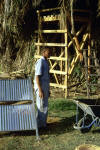
Solar water heating under construction
The day ends with a showing of the movie "Gorillas in the Mist" in the dinner tent on my computer, telling the story of Dian Fossey and the mountain gorillas on the Virunga volcanos.
Some of the African camp workers join in, which leads to an interesting observation. In the movie some characters represent members of the Batwa tribe in Rwanda. But when they speak, our workers laugh, because they actually speak Kikuyu. Apparently the movie makers didn't really have any Batwa actors, and since part of the movie was filmed in Kenya, they simply used Kikuyu actors in the sure knowledge that very few movie goers will ever notice this mistake.
Arrived in Nairobi on a commercial flight in a Cessna Caravan. Had never flown in this airplane before. Interesting! It is a single engine non-retractable plane that can carry something around 15 people in three-abreast seating. Single engine means that the plane has to be able to land at slow speeds, because the likelihood of total engine failure is much higher on a single-engine plane than on a twin-engine plane. The non-retractable gear also indicates that this is an airplane designed for slow-speed, short-haul operation.
The Cessna Caravan aircraft type won over Wilson airport in a single stride. It seems to be the most popular plane for tourist shuttle operations. The operating cost may be as low as $500 per hour, which is extremely cheap.
So what is its secret? That's the turbine engine in front, an engine that delivers enormous power at small size and light weight and is at the same time many times more reliable than a piston engine. The engine itself is expensive, but when it is long-lived and you can share the cost among a whole bunch of well-paying passengers, that's no problem.
Back in the Aero Club of East Africa, I take a rest and reorganize my things. Laundry comes first, because I'm running out of clothes.
After thinking a while about my plans and finding that there is really not enough time to go to Masai Mara or Samburu before the next group of researchers comes to Amboseli, where I want to meet them, I decide to do something I have wanted to do for a while, but hadn't made it yet—finding a new way to Amboseli.
The couple that first drew my attention to the existence of this route lives beyond Kajiado in the hills. (Let me call them J. and M., and please, J. and M., if you ever get to reading this and want your full names here, please drop me an email.) I had visited them last year already after meeting them for the first time in Amboseli. They run a tourist camp near Amboseli and do some limited agriculture on the side, such as keeping a few cattle. And they work in the fields of conservation and research.
It is practically impossible to find the place. From the road from Kajiado to Bissil and Namanga you have to turn off to the right (north), but there are many such turnoffs and theirs is not exactly the most conspicuous. Normally, when they expect visitors, they send somebody down to the street to catch the visitors and lead them to their place, but I had not been able to reach them on the telephone, so I just went there, hoping that somebody would be at home.
The first time I looked for the place, I had only a description on a small piece of paper that turned out to be quite ambiguous, so I searched for the better part of a day, until by sheer luck I found somebody way out in the countryside and quite a bit away from the real place, who happened to know J. and M. Of course, finding the place once means knowing it forever, because my GPS never forgets.
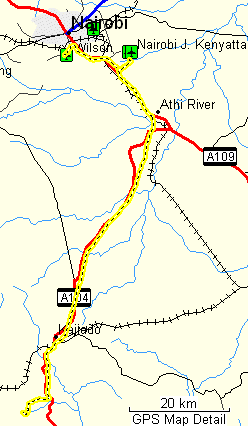
Thus it is easy for me to find them this time. I turn off the road and then turn off the track again in the right place, following the GPS route. Of course there are many turnoffs here again, so even if you find the right one from the main road, that does not mean at all that you're quite there yet.
I reached the parking lot, jumped out of the car and asked one of their employees whether J. or M. are at home. Luckily they both are, and I am quite relieved to hear that.
I find M. working on their new house, greet him, and I see the progress made on the house since last year. It's going to be gorgeous, in a wonderful setting up on the hill and an incredible view over the flat area down below and the hilly landscape beyond. Again you can see for 100 miles from there, not unlike the view from the house in the Rift Valley. Yet the house is in turn really hard to see. It blends so inconspicuously into the landscape, and trees in (yes, in) and also in front of the house make it magically invisible from down below.

Electricity comes from this device
After watching the building work for a little while and actually carrying one pole (great help that), he finishes his working day and we go over to a dining room which is actually a small house in itself, with a thatched roof and a terrace in front. There is no wall toward the terrace—the house is always open, just like Mary Leakey's house atop Olduvai Gorge.
Generous and hospitable as they are, they invite me not only for dinner but also to spend the night there in comfort, for which I am very grateful, because it is already far too late to get anywhere.
The dining room (or house) has a round table with chairs on the right side, a small cupboard in the middle, and easy chairs and sofas on the left side. After a drink we sit down to chat and exchange the latest information. We speak about elephants, about conservation in general, poaching, the football world championship and many other things.
Then they treat me with a wonderful dinner. I still particularly remember the first-class soup and the homemade fresh cheese that is spiced very interestingly and differently from any cheese I have eaten before and was a true delicacy.
After dinner we keep chatting for a while longer before going to bed. They have a tent prepared for me with all the luxury a tent could possibly offer. In fact it is the tent their daughter uses when she comes visiting. But their daughter is very busy in Nairobi at the time with her newborn child, whose appearance had made J. and M. grandparents for the first time. Congratulations! They are certainly proud.
Above the tent, up the hill, there are two little huts, illuminated with lanterns, so I can see and find them in the dark. One is a toilet, complete with toilet seat and paper. The hut actually consists of a low wall and a thatched roof that leaves a narrow gap that allows you to see all around you when you sit on the toilet. I slowly began to admire the attention to detail with which all these buildings were designed.
The other one has higher walls and no roof and is actually a washing room. There are containers with water, a can, a bowl, soap and a wooden grid on the stone floor on which you can stand and take a shower by pouring water over yourself. Of course there is also a mirror. These people know how to create comfort out in the bush, and they actually do the same for a living when hosting tourists in their camp in Amboseli.
In the morning, not long after sunrise, we had a wonderful breakfast in the kitchen, yet another building. Then I got a good description of the new route I wanted to take, and after saying goodbye, I switched on the GPS and the car engine and slowly drove down the path out of their compound.
I drove back the short distance to Kajiado, crossed the railway line, then turned right (south) into the road to Mashuru, crossing the railway once again a short distance later. The road I had just left, that branches off from the Mombasa Road in Athi River and leads to Kajiado, Bissil and Namanga, has an asphalt surface, "tarmac", as they call it here. Of course all the other roads don't offer this luxury. Most are gravel roads (called "murrum" or "marrum" or "marram" roads here in Kenya), some especially designed by pouring gravel on them and levelling it, but some simply untreated car tracks. This one was of the former kind and wide enough, so two cars can pass without having to leave the road. At least it was that wide in the beginning, and continued like that for a good part of the way to Mashuru.
I could drive almost continuously at 50 km/h on the tachometer (45 in reality), which was my normal speed that just barely allowed me to stay in fourth gear to save fuel. Below that speed the transmission gives off unpleasant noises, forcing me to switch down to third gear with the attendant increase in fuel consumption.
I had bought a gas can ("jerry can" in Kenyan parlance) with 5 extra liters of fuel, but the can was actually a vegetable oil container whose cap never really closed the opening, and when the jeep shook and danced around, I could see the petrol seep out and especially smell it. To get rid of the unpleasant smell, I poured the fuel into the tank, which didn't work all that well, because some of it always ran down and didn't go into the tank opening. Then I left the can open in the hope that the residual bit of fuel would eventually evaporate and the smell stop, which it eventually did the next day.
At this speed driving requires continuous high concentration. You can hardly take your eyes from the road and have to scan some 50 m in front of you at all times, because many holes and bumps are difficult to see in the sunlight now coming almost directly from above. To look to the side to watch the beautiful landscape I had to make a conscious effort to scan a bit more of the road ahead and make sure it was free of holes and bumps. Then I could look to the side for very few seconds before having to concentrate on the road again. A big hole or bump requires emergency braking with all four wheels blocked. If you cannot get the car to a very low speed before the obstacle, you have to let go of the brakes in the very last moment anyway, because going into a ditch with full brake can damage the suspension. (See also the article on how to drive a jeep in the Kenya safari plan or the German version of the same.)
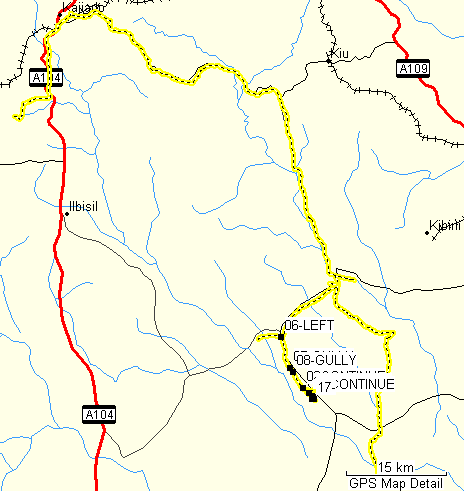
The first town I reached and passed through was Imaroro. About an hour and a couple of river crossings later I drove into Mashuru town, only to find a lot of tracks going from there in all directions, but after asking some people I was directed back to the main road that actually bypasses Mashuru on the left (east) side.
My next waypoints (but not yet GPS waypoints—driving this route for the first time I was taking the first waypoints as I went) were Selengei and then Lenkisim, but I noticed soon that the main roads were also in Garmin's WorldMap, of which I had loaded the entire Africa into my little eMap that was attached to the windshield of my jeep. Garmin's map coincided with the Kenya Route Map (on paper), which I used for further reference, and showed a main road leading more or less straight to Meshenani Gate, my gate into Amboseli, at which I could obtain a smart card for the new KWS (Kenya Wildlife Services) system.
I began to look for the road I could see in both maps. At first I drove right past, because I didn't see any turnoff. After going on for about half a kilometer I turned back to the little village named Osilalei, suspecting that the turnoff was the one leading into the settlement. Actually, settlement here means three little shops in a row and a nearby boma, nothing more.
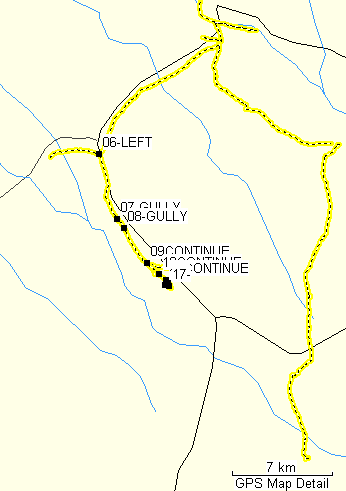
The topmost turnoff, that I initially missed, is Osilalei
Sure enough, the turnoff with the sign was the only one and also the one I was looking for. For good measure I asked the people standing there, and they told me, yes, the road was good and yes, it leads to Amboseli and Meshenani Gate.
So I went on into the Selengei river that flows parallel to the road I had come on. No water at this time of the year, and somebody had generously put some branches into the deep, soft sand, so I didn't even bother to use the four wheel drive.
Climbing out of the riverbed, the road then branches. I compared this with the map and concluded that I had to take the right branch to find that major "road" to Amboseli.
Initially I took one too far to the right, that led me back along the river. I turned back and found the one I wanted (see GPS track picture above).
The track was good, but infrequently used. I could only occasionally make out any actual tire tracks. But I could still mostly drive at high speed (45 km/h) and covered the kilometers in decent time.
Then came the next branch (waypoint 06-LEFT in the GPS track picture). According to the paper map, the road should just bend to the left. According to the Garmin WorldMap, there was a dashed line branching to the right and crossing several rivers, and an unbroken line (bigger, better road) branching to the left. But in reality I could only see the road that continues to the right and nothing but thorn bush savanna to the left. I drove up and down the road, but there was a clear corner which showed a structure as if the third road had actually branched off exactly here.
So I looked in the direction of the theoretical road and suddenly noticed that I could look a mile down that direction without seeing a tree. There were trees to the left and trees to the right, but in the middle there was a clearcut gap without a single tree. This must be the road, but on it the grass and some smaller bushes reached up to my hip. This road has not been used for five years, I thought, and decided to have a go at it.
I turned the jeep into the gap and began to drive into the high grass. Initially I drove very slowly in first gear, but as the road still seemed to be smooth and free of holes, I gathered courage and shifted into second gear, now making about 10 km/h.
At this speed I kept driving for a long time, and the overgrown road held its promise nicely. Then I came to a place where water had run down the road and washed out an ever deeper gully, so I could not continue there. I turned off and drove parallel to the gully, winding my way through the thorn trees.
After a while the gully ended, so I could drive in again and continue along the erstwhile road. But not too long afterwards there was an even deeper gully, and I had to drive parallel to it again, this time on the other side. I regained the road after a while and looked carefully at the map on my GPS display. It showed the road about 500 m farther north of my position, while until a couple of kilometers back the road had been fairly precisely under my track. The thought occurred to me whether I was perhaps driving on a parallel road and a poor one, while the real road was just 500 m to my left.
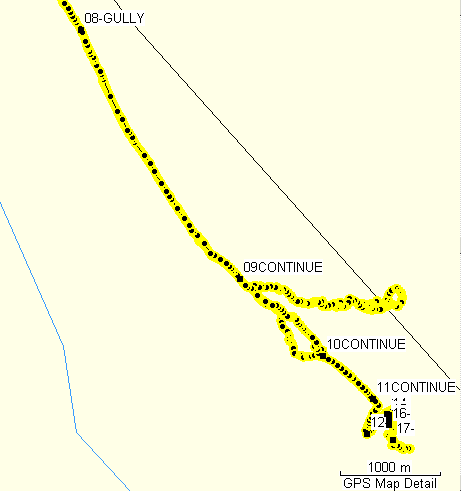
So I turned to the left and made an attempt to find the road where it was on the GPS. Unfortunately the trees and bushes were now so dense that it became ever more difficult and risky to continue, due to the thorns killing my tires. Sure enough, there was also no road. At least I couldn't detect any. I believe now that the road I had been travelling on is the only one there and that the map was just inaccurate again.
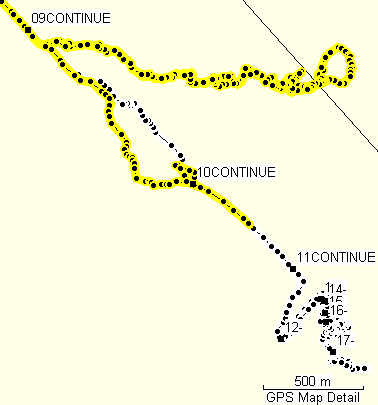
Searching for the road. First part of track is yellow, second part is white.
I thought about cutting in forward to regain my former road, but the terrain was by now so difficult that I had to use the GPS to backtrack. Unfortunately the GPS is not precise enough to record every little maneuver around every single bush or tree, and my tire tracks were not always visible, so even backtracking became a tiresome and difficult endeavor. The whole excursion to find that other imagined road took about an entire hour.
Eventually I got back to the last waypoint I had set on the GPS on the original road and drove on. After a short distance I encountered a first gully across the road. I crossed it by driving right through, but a second one followed, deeper than the first. After a few more I eventually encountered a gully that was to deep to cross, so I had to turn off the "road" again to find a way across that gully. I found it only a few meters away and returned to the road. But only a few meters further there was the next gully and then the next again, ever deeper and deeper. I found myself driving a hundred meters down the gully before I could cross it, then drove back up to regain the road.
I could find the road only with the help of the GPS. I saw my former track along the road and mentally extended it to my position, then tried to hit that extended line. This worked one time, but the next time I could not find the road again and began to zig-zag along the presumed way, getting deeper and deeper into the thorn bushes and trees.
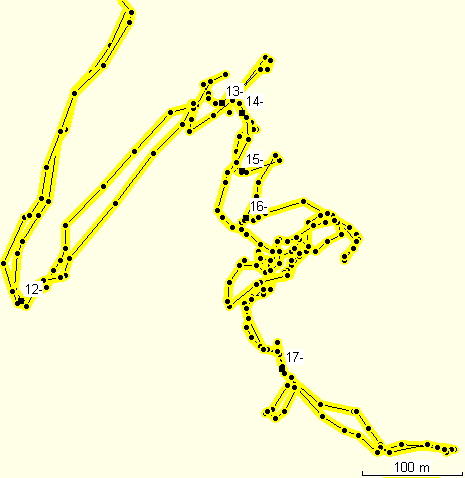
Getting stuck, giving up and turning back
The time was 15:11 and the remaining distance to Meshenani Gate only 20 km, when I made the very difficult decision to turn back. Meshenani Gate was already in walking distance, and probably it is possible to get through and reach my destination, but the risks involved seemed too high for me at this point. The tank was reading less than half. The thorns bore the very high risk that my tires would go flat, creating a real problem for me when two of them would go. And it became increasingly difficult to find any way at all through the thorn trees.
So I very reluctantly turned the car around and began to look for the GPS waypoints I had thought I had already left behind.
After a while I was driving on the abandoned road again, this time third gear, which requires some considerable boldness, but since I had driven the road already in the opposite direction, and most of it was good, I increased the speed to almost 30 km/h, hoping that I wouldn't hit a hole while not putting the wheels into the same track that I had come on. Sometimes my tire tracks were visible, but often they weren't, but anyway, it worked.
Back to the branch and now again on the more visible track, I now turned left to explore the other direction in the hope that there would be another turnoff to the left in my desired direction. But after 10 km there still was none, and I decided again to turn back.
This time I had no choice but to go all the way back to Osilalei, or at least to the branch by the river across from Osilalei. After driving back the long distance, I reached the river, turned back again and this time took the left branch leading me further to the east.
This was the better way. The road did curve back to the left, possibly in the direction of Selengei, the town I never reached, but before actually going back to the big main road, I hit another one that allowed me to do a steep turn back into the direction of Amboseli.
This turned out to be the road I wanted. It gently meandered its way towards Amboseli. But by now I was slowly running out of daylight with the sun setting around 6:30. The clock read 5 pm, and I decided that after 5:30 I would begin to look out for a suitable camp site. My biggest concern was to be not seen camping, because I would be vulnerable with the car parked somewhere out in the bush, and though most people around here are very friendly and helpful, there's always a risk of hitting the few wrong ones.
I drove through a rather dry highland area where I didn't see anybody and no cows either. The time read 17:30 (5:30 pm), and, according to plan, I began to look for camp sites. I saw one, a group of bigger trees and bushes not very far from the road. I turned in and stopped the car, only to hear cow bells from not far across the road. So I drove on.
Now I saw a few people and cows, passed by some military-looking building with an antenna, then I came to Lenkisim mission, a fenced-in square with a few houses and two African women sitting on a bench, leaning against the house wall. I pondered the thought of asking whether I could stay in their compound, but then I felt that my whole improvised camping would be difficult to perform among lots of onlookers, and so I drove on, probably a mistake, but I would learn that only on my way back.
By then the time read 6 pm, and my last half hour of daylight had begun. After a while I reached dry highland again, and the cows became rarer. Soon I was on my own again.
When I crossed a shallow river bed, I turned off the road and drove parallel to the river bed for a short distance, then I saw a grove of trees and bushes that looked suitable. It was not far from the road at all, but the car would still be invisible, because it was standing lower in the river bed than the surrounding plateau and well hidden behind the bushes. So I backed into the bushes and made camp.
I was not really equipped for camping. My equipment consisted of a mattress for the car, whose rear seats had been removed, my sleeping bag, a bed cover into which I could crawl to have a second, more easily washable layer inside my sleeping bag, a few bottles of Sprite, some cookies and two tins of beans in tomato sauce. No water for washing or brushing my teeth, but then I don't do this very often. I made a mental mark though to think of some water the next time, then I removed the spare tire and one suitcase from the car to make room and made my bed for the night.
I had brought two pieces of insect gauze for the windows, but they turned out to be just slightly too small. When I pulled on one end, I lost the other. After many attempts I gave up and left both windows open a bit, in the hope that there would be no mosquitos, and if there were, that they wouldn't be malarial. With the thin human population around, I guessed that my chances would be reasonably good. After all, the mosquitos have to pick up malaria from somebody else before they infect me, and if nobody is around to provide the parasites, I would go free, even if a few mosquitos stang me during the night.
In fact, I had already bought a cheap mosquito net when I couldn't find insect gauze by the meter, to cut up and make window screens for the car. The next time I see the possibility of having to camp out, I will do exactly that.
But luckily there was no mosquito there at all. It was apparently too dry for them, and my night was quiet and uneventful.
I woke up a few times during the night, because of the slightly uncomfortable bed in the car, and admired the moonshine and the sounds of the night, mostly insects calling their mates, but I always fell asleep again. At the first sign of dawn, at 6 am, I finally woke up and lay awake for another 15 minutes before gathering energy and crawling out.
Rolling up the mattress and the sleeping bag and putting the spare tire and the suitcase back into the car didn't take long, and soon I was on the road again. The sky was now overcast, as usual in this time of the year. It should remain overcast and cool for the entire rest of the day.
I entered Amboseli National Park on a road without gate and turned right to go to Meshenani Gate to pay my dues. The people at the gate had changed. The cashier was still the same, and he recognized me immediately, but the ranger was now a woman, a strikingly good looking one in her professional camouflage dress and ranger cap. I paid for three nights and left some more money on my newly issued smart card, so it wouldn't be taken from me when I left, which turned out not to work, because the temporary smart cards are always taken back when one leaves.
On the way back from the gate into Amboseli I had a most peculiar encounter with an ant raiding party that I do not understand. The ants formed a short line of perhaps one meter in length, so it must have been a fairly small raid. Apparently they were just coming back, because several of them carried some small prey that I couldn't identify, perhaps termite larvae or some such.
But I noticed the ants too late and rolled over them, killing quite a few with my tires. I hit the brakes, jumped out of the jeep and walked back. At that moment I saw that the line had dispersed and a whole army of ants, covering an area of at least one square meter, was walking briskly towards my jeep.
I can only come up with a few wild hypotheses. Either they somehow saw the big thing that moves, in the very second their sisters released their alarm pheromones while being squashed by the tires, and immediately followed the optical signal to counter-attack, or perhaps they followed the pheromone stamps that my tire put down after each revolution. If anybody has heard of this behavior, please drop me an email.
I jumped back into the jeep and pulled several more meters back, then went back to keep watching the ants. But now they changed direction, turned off the road and disappeared into the grass.
So I drove on through Amboseli towards the Ol Tukai Lodge to greet Soila, who didn't know I was coming already today. After I told her the story of my journey, she immediately offered me a tea for breakfast, which I couldn't refuse. We sat for another moment, then I left for the research camp, in which I was hoping to be able to take a shower to get rid of all the dust. I had left Kajiado with a white shirt, which wasn't very wise, because now it had more of a reddish-brown color from the red soil dust along the way.
I reached the camp, and found P., the man who essentially runs the camp, but also S., who works with him but had been away when I had been there before. Of course he had some warm water for me, and when I washed my hair, the foam I rinsed out was red-brown too. What a relief!
The shower in the research camp is a wooden shed that has an opening away from the camp, facing the swamp, through which it can be entered. From a wooden gallows a plastic can with water is suspended by block and tackle. P. fills and pulls it up, and a tap allows the water to flow through the shower head. Actually the many little water jets in the shower head are misleading, because when you open the tap enough to use all of them at once, your joy will be short. After a minute or two it's all gone. So the trick is to use only a trickle of water to do most of the cleaning work and get rid of most of the soap again, and only then perhaps turn it fully open to enjoy the shower as long as it lasts.
I changed my dress and had this wonderful feeling of being clean.
In the evening I drove out with David, a young Maasai zoologist who knows much more about the elephants and other things here in Africa than I do. We met a bunch of elephants and observed their behavior, a small family group that was being visited by a large bull. Two young bulls had a mock fight, and we could hear the loud, clacking sounds when their tusks met.
In the evening I showed the movie "Titanic" in the dinner tent. The movie show was a great success—everybody liked it.
The sky changed from overcast to sun several times, but in the end it remained overcast, and the mountain covered in clouds. After the many activities of the past days I was lazy and didn't even go out for a game drive in the morning.
Later I drove over to the research house in Ol Tukai to meet Soila and Nora, two of the three research assistants who record most of the elephant observations these days. The third, Katito, was away for a short vacation.
We agreed to meet in the camp an hour later for some GPS training (track recording and archiving), but before that I drove over to the petrol station at the Amboseli Serena Lodge to fill my almost empty tank.
On the way back I saw a dung beetle (for more info click here, then click on Star Insects, scroll down and click on Sacred scarab) rolling her dung ball, much bigger than herself, across the track. I jumped out of the car and shot half a roll of film, because the dung beetles had so far eluded me. She actually began digging a hole, but there was one straw of grass in my camera's way, so I tore that out. This, however, frightened her. She stopped digging, and after a long time she left the hole she had begun to dig, recaptured her dung ball and rolled on.

Digging a hole, pushing out the dirt
So I went back to the camp, and soon thereafter Soila, Nora and David arrived for the training. The topic was easily covered, and after two hours they left again and drove back to the research house.
While I write this, I should perhaps describe the situation, because it is quite unusual. I'm sitting in a tent with large insect gauze windows all around. I have driven my jeep close to the tent, and the hood is open. A black and a red cable are connected to the battery contacs. The cables lead to an inverter that produces 230 V alternating current. From this my computer is fed, which plays some music at low volume (Suzanne Vega at this moment, but in fact I rarely play music here, usually preferring to listen to the sounds of the wild).
When I raise my eyes, I see a group of elephants through the window, slowly passing by while eating. Next to them there's a herd of gnus. When I raise my view even further, I see the gigantic mount Kilimanjaro with its snow-covered top. This is the highest mountain in the world, when you measure from the surrounding plateau.
In the afternoon I drove to the Ol Tukai duka (shop) with P. because we had run out of sugar. After that I drove out to spend some time out in the bush with the wild animals.
In the morning we drove to the airfield to collect the couple that had be my earlier hosts in the house on the edge of the Rift Valley. She came down to get a new subproject going, and he came to finish the construction of the new solar water heater. He had brought pipes, taps and tools and immediately began with the construction. She looked at the already standing frame and immediately noticed that the device was facing southward while it should be facing west. The second she said it, it became clear to me that we had made a very stupid mistake when first setting it up—our minds were set for Europe, where, of course, it would have to face southward. But here, two degrees south of the equator, this makes no sense at all. Neither would facing north help much, as then the device would collect hardly any heat during the northern hemisphere winter.
The device comes from China, and the inclination of the solar panel of glass tubes is somewhat too steep for the tropics, I estimate almost 30°. So a compromise has to be made, and that is having it facing west. East would, in theory, be just as good, but practically there is often cloud cover in the morning and sunshine later during the day, so west is the better choice.
Unfortunately the wooden rectangle on which the four metal feet rest is not exactly a square, and the four feet of the wooden support construction are already anchored in concrete, so the easiest way is to put two more wooden bars on top of the existing construction and support them such on one side that the required overhang is stable. He did just that and turned the solar heater around by 90°.
Unfortunately the water pipes he brought were not quite enough, so the final construction will have to wait until some more high-quality pipes have been transported to Amboseli.
Also coming was a woman with her little daughter who studies baboons in Amboseli and whom I had met already a few years ago. I had always been interested in that project, and we later made an appointment that I could visit her project the next day.
After taking all the new guests to their destinations, it was decided to get the GPS track archiving going immediately, so I installed the required software on the new computer in the research house (on the compound of the Ol Tukai Lodge). That took a while, but with the help of a new data cable, that had been brought from Nairobi, we were now able to download GPS tracks from a Garmin 12CX GPS receiver, see the tracks on the screen, and save them to disk, a procedure that I had taught and tested already yesterday with my own GPS that uses a different cable.
For the other subproject, gathering long-term information about the presence of elephants in outlaying areas outside Amboseli National Park we would initially use Excel, so it was decided that I should give David some additional training in the use of Excel this afternoon. David is a quick learner, so I actually looked forward to this, and indeed it went very well. I showed David the essential functions he needs for his work and then quite a bit more. He learns more rapidly than most trainees I have had back in Europe, but he has had only very little access to computers, so he is inexperienced in the use of keyboard, mouse and elementary Windows functions like the clipboard and shortcut keys. Nonetheless everybody has only good things to say about him, so I hope he will get more opportunities to work with computers.
I drove out in the morning of my last day before my departure back to Nairobi and, among looking at the wild animals all around, went to the Observation Hill and tested whether my mobile phone would work at the top. It didn't. High enough perhaps, but too far away from the nearest cell transmitter, which may well be 100 km away in Kajiado or Bissil or somewhere along the Mombasa Road. Thus the only electronic connection to the outside world, short of a satellite phone which I don't have, is the telephone in the research house, which works over a special radio link.
I had intended to use the portable radios to ask the head of the baboon project when would be the best time to come, but now I was already almost there, so I just drove on and dropped in. Fortunately she was not out in the field, so I got a chance to have a discussion with her on the baboon project and particularly about the baboon database.
The database has, of course, many similarities with the elephant database, but the observations are much more centered on behavioral and sexual status parameters of the individual baboons, which makes it more complex. For example, there is a table of interactions between any two baboons. This yields a more complex link structure. On the other hand there are not quite so many general and environmental parameters. I found the database fundamentally sound, well structured and very impressive in its richness and could contribute only very few proposals for small improvements. As the database is planned to be shifted to a SQL engine that I have no experience with, it is unlikely that I could contribute by actually working on it.
So I thanked her for the good insight and set off again to take a few more photos before returning to the camp for lunch.
In the afternoon there was an internal meeting which concerned me only marginally, so I didn't fully take part. After that a group of visitors was planned to come to hear a speech by Soila about elephants and the project. As she didn't feel quite well, she asked me to jump in and take at least part of the burden from her, so I began to explain the life of an elephant and carried on until I reached the limits of my knowledge. Then she continued, and we worked very well together by taking turns at explaining various details. My general knowledge about elephants is meanwhile quite good, though of course not as detailed and precise as Soila's. I believe we did a good job at complementing each other and keeping the listeners informed and interested.
In the evening I drove over to Ol Tukai to call the Aero Club for a room the next day and the head of the project for further plans regarding yet another return to Amboseli when she would also be here. As it turned out, a further visit was planned for Tuesday or perhaps Wednesday if I didn't make Tuesday.
After breakfast I set off for Nairobi to collect my laundry, spend one night in the Aero Club, then proceed to Embu to visit the project of the anthropologist I had met before, but it turned out that I had to change my plans, because the time wasn't really enough for all of this. I decided that I would have to drive from Nairobi on to Baringo, where I already had an appointment for Sunday, the 23. June.
I decided to use the new route from Amboseli to Kajiado again, this time in the other direction, to check the GPS waypoints again and enjoy the interesting views along that route.
First I had to go to Meshenani Gate to check out of Amboseli National Park. I had overstayed my planned time by one day, so I had to pay for the additional day, but as I then learned, they count exactly every 24 hours as one day, and I was by now 8 minutes into the next, which cost me an extra day. Live and learn. In fact I had waited there for at least 8 minutes, but there's apparently no way to tell that the machine.
Then I turned back into the park, then left (north) on my long way to Kajiado. After a short distance I saw a track branching off to the left from the main road. Ah, a shortcut, I thought, and turned off.
Indeed the track turned out to be a slight shortcut, leading almost parallel to the main road in an easterly direction. But it is both better and more beautiful than the main road, in addition to shaving a small distance off the total. It leads over a flat hilltop from where I could overlook the entire Amboseli National Park. I even stopped and tried the mobile phone again, but to no avail.
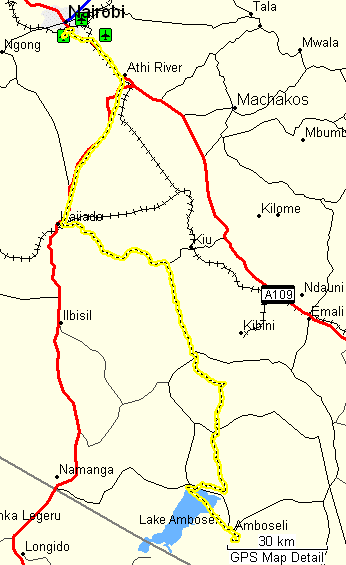
Shortly after that I hit the main track to Lenkisim and Osilalei and turned left (north). After some time and a couple of kilometers later I came to the mission at Lenkisim and turned around the corner of the fenced mission compound. A big white Pajero jeep was just about to leave the place, but as the driver saw me, he stopped again and waved hello. I jumped out of my jeep and walked over to the man and his female passenger.
It turned out that both are missionaries from Mexico. Father John Reyes is currently stationed at the Lenkisim mission, while Patty Glez P. is normally in Mashuru, but was just visiting Lenkisim.
The next moment they invited me to a cup of tea, even putting off their departure for this. I agreed and entered the pleasantly furnished main building, where a tasty fruit cake accompanied a cup of coffee. (Tea turned out to be finished while the coffee was already there and ready to drink.)
We chatted for a short while and exchanged information. The most surprising bit was that this mission belongs to the same group of missions that also encompasses Katilu, which used to be one of my regular visit points in northern Kenya in the days when I still worked in Kenya and when it was manned by two Italian missionaries, Mario and Dario, whom I knew quite well until they moved to another place out of my reach.
We agreed to meet again and went to the cars. Walking out, I admired the whole setting. A fairly big chapel to the left and more buildings on the right side made the mission almost a small town.

The chapel of Lenkisim mission
A bunch of children stood in front of the church, inviting my camera to a picture, then I drove out and continued on my way towards Osilalei.
After a few more kilometers I passed right through the middle of a small settlement with a stone building, perhaps a chapel, to one side of the center. Under a tree on the other side I saw a blue cross van in front of a table, where a white woman and her three African assistants worked in the middle of a whole lot of Maasai women with small children. I drove by, but then my insatiable curiosity got the better of me. I turned the jeep around and drove back, parked it and walked over to find out what was going on. I heard some of the children screaming from the top of their lungs. It turned out that this was a campaign against measles. The children were inoculated against the disease.
After watching their work for some time, I asked the white lady whether she would mind if I took a few photographs. She replied, yes, I could take photos, but only of herself and her assistants. So I mounted the wide angle lens and used this old trick to document the whole situation by pointing the camera at the table and seemingly photographing the injection equipment, while the 24 mm wide angle lens captured the entire scene. I took some more photos from the hip, especially one where the injection needle was used on one of the children.
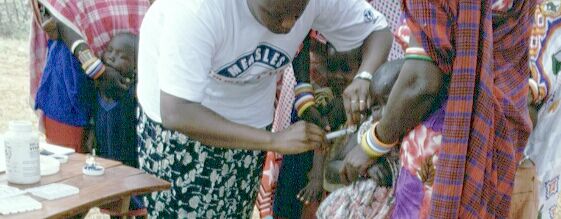
Injection
Then I jumped back into my jeep and drove on. The landscape keeps fascinating me every time. The road led me through flat, sandy valleys and over green hills, until I reached the junction where I had once taken the wrong turn. I drove down into the valley of the Selengei river and crossed the dry riverbed once again.
Past the three shops of Osilalei and left onto the wider main road, the direction was then pretty much north.
After quite a distance I saw a hitchhiker next to the road, which is quite common in areas like this. As I passed him, I thought to myself that the man looks like a teacher and slammed on the brakes. His destination was just short of Kajiado, so we drove on.
Sure enough, he was a teacher. We had a very nice discussion about many interesting things like the education system and its problems. He even brought up the question of circumcision and, like me, saw it as a problem. We discussed the drawbacks of this cultural trait and agreed that much, but not everything in the traditional cultures is worth keeping.
After another hour he dropped off near his home village, and I continued to Kajiado, where I turned right onto the first paved road I had seen in several days, and continued back to Athi River, where I turned left onto the legendary Mombasa Road and merged into the denser traffic that flowed in the direction of Nairobi.
Back in Nairobi I first went to Rasul's to have the car radiator cleaned and the oil checked. Very kindly, they cleaned the entire car and even my luggage from the layer of red dust that had crept into each and every gap and covered everything. Only my trousers and my shirt kept showing the dust. After a tour like this the clothes always have to be washed, and a shower is also inescapable. But I would not get that before arriving in the Aero Club.
Before entering the Wilson Airport gate I passed by the Internet café and saw that it was still open. So I parked my fully loaded jeep directly in front of the door and went in to exchange the latest information, not least uploading the last version of this travel report. Then I continued on to the Aero Club.
In the Aero Club I first moved into my room, took a shower and pulled all the dirty laundry out of my travel bag. Then I went into the club restaurant and had a plate with gnocchi and a Sprite to still the thirst. Finally I retreated to my room and answered a few emails that I would send the next morning. Then I went to bed.
This was the day of the summer solstice in the northern hemisphere—the longest day in the north and, by a much smaller margin, the shortest in Kenya south of the equator.
Early in the morning I got up and packed my things into the car before going into the club restaurant for a small breakfast. Then I collected the laundry I had left here the last time for washing and replaced it with a new set of dirty clothes. Then I drove out of Wilson Airport, stopping again at the Internet café to upload this text and the email replies I had written the evening before.
There I made one last call to Baringo announcing my coming and was asked to bring a toner cartridge from Bytec, the best computer shop I know in Nairobi. So I drove over—it was almost on my way anyway—and collected the cartridge. Then I went on to resume a preprogrammed route on my GPS through the western outskirts of Nairobi and came through some areas with very impressive gardens and villas before I hit the right road.
My way led me through some poorer areas at the edge of Nairobi and finally onto the highway to Nakuru. The road, initially a four-lane freeway with a barrier between the two double lanes, climbs higher and higher on the eastern edge of the Rift Valley until it reaches 2,700 m above sea level, at which point it has already shrunk to a normal two-lane road, then it curves down into the valley near Naivasha. Up to that point the quality of the road is excellent, but past Naivasha it gets rather rough and uncomfortable. I reduce my speed to the usual 50 km/h. Fortunately there are at least no big potholes.
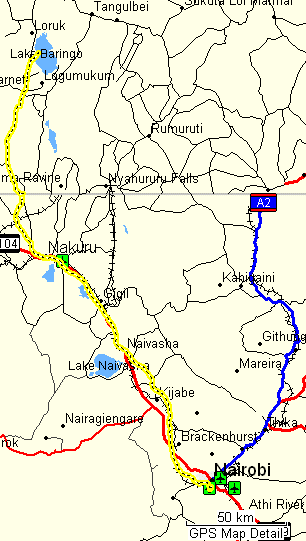
The road continues past Gilgil and Lake Elmenteita. The lake has a wide pink seam along its eastern shore. These are all flamingos, many thousands of them. I slowly drive by and continue to Nakuru through the abandoned toll station and always having the Uganda railway to my left. I make a mental note that there are gas stations all along that road, all the way from Nairobi to Nakuru. So this is one of the very few roads in Kenya along which you can actually drive with your tank less than half full.
I slowly drive along the main road into town, actually past the northern edge of Nakuru, and don't even stop there, because there is no time for Lake Nakuru National Park today and I don't need to go shopping either.
The GPS signals the turnoff to the north, and I leave Nakuru again on my way to Baringo. Shortly before reaching the equator there is one last big gas station worthy of its own GPS waypoint, where I fill my tank once more.
At the equator I try to reach the point where the 36° meridian crosses the equator. I had marked a tree at that point a few years ago to provide some thrilling experience to the GPS afficionados who search for "geocaches" and "confluences" as a sport. Indeed my marked tree had already been found and visited by at least two parties (see my GPS page). But this time it had rained, and I almost got stuck along the trail, in spite of four-wheel-drive and first slow gear. The water had washed out part of that road, and the wet soil was slippery like soap. I tried a few other ways out of the situation, then I spent several minutes carefully turning my jeep around, which was already very difficult. This was only 3 km from the point, but I had to give up. I also didn't feel like leaving the jeep behind and walking three km in the blistering early afternoon heat, so I drove back to the road and continued my journey to Baringo.

The fight against measles has reached Marigat as well
I reached Marigat and slowly drove past the little town. This time I didn't bother to take another few liters of fuel, because I would most likely not continue to Samburu, unlike most previous years. I could always fill my tank in the Lake Baringo Club, albeit at a much higher price, but closer to the destination, should I change my mind.
Finally I arrived at the Baringo turnoff after about 6 hours since Nairobi. I drove to the barrier, talked to the woman in the office, told her that I'm not a tourist and refused to pay. The barrier has no legal basis and is something akin to medieval road and bridge taxes in other parts of the world. With my rudimentary Kiswahili and my Kenyan civil aviation license I'm probably a rare case that falls outside the experience of the people at the gate, so they do not really insist and let me go without paying.
I drive through the tiny town of Kampi ya Samaki (fish camp in English) and through a landscape that looks like a huge garden, but is really entirely natural, on to the compound where the people live whom I wanted to visit.
They welcomed me and introduced me to a new student, a young woman from the US, of Indian origin, who came here through some Peace Corps programme and is happy to work on the projects here.
We used the remaining few hours of this Saturday afternoon to go through a whole list of computer problems, but solving all of them took less time than I first feared.
I got to see the new house that was not quite finished yet, but already showed its future beauty. The main house, into which I was invited to spend the night, is a fascinating construction of curved stone walls with a thatched roof that combines the best of the African construction ideas with a very stylish, light-hearted architecture, a front porch with two arched glass doors facing Lake Baringo, many windows all around under the roof that overhangs by about 1.50 m, giving shade throughout the day.
Temperatures are high here, around 30°C even in the late afternoon, but the air is usually quite dry, so cooling by sweating works. Sometimes one needs a lot of sweat though. And they told me this is the coolest time of the year!
We sat together in the evening, chatted, discussed, and told stories like the one of the 9 swimming elephants who suddenly showed up on 1. April this year and apparently walked the long way from Laikipia to the Kerio Valley, where there is a small isolated elephant population. Some time later two of them came back, hid in the bush from the hundreds of people who had come from all around to see them, then went into the lake and swam across at night. Some days later the rest came back too, entered the lake at precisely the same point, and swam back as well.
They showed me a little animal that had fallen out of their thatched roof when it was about the size of a thumbnail. They had fed it with cereals and milk, and it had grown nicely and is now tame.
The species is unknown. It could be a strange animal called the "flightless flying squirrel", but they are not sure about this.
Finally we went to bed. I got the room of the hosts' son who was in a boarding school at the time. Windows and door remain open to let a gentle breeze into the room during the night, but at least one half door in the corridor needs to be closed unless I want snakes in my bedroom. Bats fly through the room, and I hear the never ending concert composed by insects and birds.
My bed has a big mosquito net that falls down to the ground all around it. What a wonderful feeling to hear all the mosquitos, yet know that they can't get to me!
I woke up early in the morning and from my bed saw the sun rise over the lake. This place is enchanted. In front of my window is a lawn, stretching the few meters to the almost vertical cliffs, into which my hosts have constructed a terrace at a lower level than the garden lawn. I slowly sank back into the pillows, realizing that this is a Sunday and nobody would get up at sunrise.
After some time I woke up again and shifted myself out of bed. After a good breakfast with cereals, milk, toast and marmelade we moved down to the office building, a low barrack-style stone house, also with an overhanging roof to prevent that the sun heats up the walls too much.
We worked on the computers for some time, trying to get an older one to do useful work and trying to connect computers through a serial cable. Later I went to the family of my godchild Asha and spent the whole evening there. Asha's sister Salima now goes to the university, which is quite a success for somebody coming from such a disadvantaged background, and I try to support them and contribute to the cost.
My original plan was to leave in the morning after finishing a few tasks we had not quite completed on the day before. After doing that, I was about to leave, but they called me over into a little house where they have something like a small emergency clinic, formally the RAE Dispensary. There is no doctor here, but in this remote area one has to learn a minimum about treating burns and other injuries.
I came into the small room and saw a little girl, some 5 years old. I look into an oval face with a high forehead, almond eyes and a small mouth with perfectly shaped lips, in other words, she is about as beautiful as a girl can be. But she appears apathetic, looks sad, does not speak. Her name is Chemandazi.
Then I see her left arm. At first I cannot believe what I see. The flesh is missing on much of the upper surface, from the entire back of the hand up to above the elbow. Pieces of gangrenous, blackish, rotting flesh dangle above a yellow-white layer of pus on the surface of the muscles that still cover the bones and are visible in some places. At some other points traces of blood seep out, but most of the huge, open wound is almost white.
My host tries to carefully cut off the dead parts of the flesh, at the same time cleaning the open area with sterilized water. She uses a scalpel to cut and a big injection device without needle to rinse the wound. In some places, when she injects water into a deeper cavity, it comes out in other places. She cuts out big pieces of what once was a beautiful child's arm, because they are already dead and rotting.
I watched for several minutes, trying to accept the terrible reality in front of my eyes. Then I lost self-control. I stood there, could no longer hold back the tears, and finally had to leave the small room and step out into the relentlessly burning sun. At that time I almost passed out. I already saw black and quickly walked a few steps to get my blood circulation going again. The searing heat certainly contributed, but the heat alone doesn't normally get me. The smell of the rotting flesh didn't help either, but the real cause wasn't that or any immediate sensory impact, instead it was the feeling of deep empathy, unimaginable sadness and the inability to help this terribly suffering human being, that finally got me.
After a few minutes I regained my composition and went back to Chemandazi, the sick girl.
I thought about calling off my other plans and driving her to Nairobi Hospital, so she could get the best possible treatment, but this is out of proportion to the normal life out there. To be fair, I would have to help many other people likewise, which I cannot possibly do. So I gave my host enough money for the girl to be treated in a nearby hospital and asked the mother whether I could take photos. She agreed, and I shot a roll of film during and after the treatment. Chemandazi hardly noticed. I tried to get her attention by letting her look through my camera, but she was too weak and dazed and I had to give up.
The big question is whether Chemadazi's arm can be saved and whether indeed her life can be saved. One more complication, sepsis or other, could kill her quickly. But even if she lives, her arm may yet have to be amputated.
But there is hope. Chemandazi has survived for much more than a week already and still looks otherwise healthy. Antibiotics can perhaps hold infections at bay. She can, miraculously, still move her fingers in the sick arm a little bit. I wish her all the luck.
2002-07-17: Chemandazi is now in Nakuru Provincial Hospital. She is alive and relatively well, and so far her injured arm has not been amputated.
I just received an email from the person who visited Chemandazi in the hospital. She is Rashi Gupta, a young American Peace Corps volunteer who works at the project in Baringo. (Too bad I didn't take a photo of her!) She writes:
... I visited Chemandazi in Nakuru Provincial Hospital where she was referred. She looked better in that she was alert and her eyes were shining (not dull like they were when you were here). Her arm was covered in bandages so I didn't see the progress on the arm, but I felt that she was getting better.
Since then, Elizabeth has called the doctor in charge of her treatment and talked to him. Although she hasn't yet received a blood transfusion, the doctor said that a consultant would come on Monday (15 July) to assess her need for skin grafting. Elizabeth feels that she does need grafting and that it would be best if we could send her to a private hospital. Of course, for that, we will need every donation we can get. ...
2002-07-18: The first donation, from Hilary C., USA, is under way.
2002-07-19: A substantial donation comes from Jon R. K., USA.
Thank you in the name of Chemandazi! (Please send me an email if you accept that your full name appears here.)
2002-11-14: Javier G. passes through Baringo on his Kenya trip and delivers a gift to Chemandazi. He writes:
I am finally back from my long safari. As planned, we delivered the Barbie doll (along with the spare suit we bought ourselves) at Roberts' Camp in Lake Baringo. Unfortunately we couldn't see Chemandazi, she goes to the small clinic for the cures thrice a week but we only spent one night there and there was no chance. The Roberts weren't there either, we couldn't meet them, so we gave the doll to a British woman that works with the Roberts at the camp. She had been working there for just a few months and didn't know about the story, but she phoned the Roberts and she got the latest update. The Roberts told her to thank you for your cares, and said Chemandazi is doing well, she finally didn't lose her arm, but there is still a long way ahead of treatment and rehabilitation. They said that any further help would be greatly appreciated.
So, this is the scoop. I would appreciate to have more news on how the girl's doing in the future, Hans.
2002-12-02: Email is finally working again, and here's another mail from Rashi,
which I reproduce here slightly edited and abbreviated.
----- Original Message -----
From: E. & M. Roberts
To: Hans-Georg Michna
Sent: Monday, December 02, 2002 6:33 PM
Subject: Chemandazi
Hi Hans! This is Rashi here - I'm still around. ...
I wanted to give you an update about Chemandazi's progress. She's doing well - smiling and playing with her cousins. Her shyness is slowly being overcome as she continues to come here three times a week. The wound on her ... hand has been closed for a long time now, but the wound on the forearm is very slowly continuing to heal. We think that we have reached a plateau for her arm - that is, we have reached the limits of what we can do here in our dispensary. Hence, Elizabeth has arranged for Chemandazi to have skin grafting done on her hand on December 16 at a private hospital in Eldama Ravine. A surgeon from AMREF is visiting and he is going to do the procedure. In fact, Elizabeth will take Chemandazi up to the hospital herself.
The Barbie did in fact arrive intact and we presented it to Chemandazi that same afternoon. We tried to find the person who carried it here so that he/she could do the honors, but we couldn't find him/her at the campground. Anyway, Chemandazi was quite pleased with her gift ...
Anyway, she was very happy to be given the Barbie and though she is very shy, she did say "sere nyaman" (thank you in Pokot).
... Chemandazi has become a part of RAE in a way - the whole staff here knows her and comes to see her progress in the dispensary. We have tried our best to give her the best possible treatment - now it's in the hands of this surgeon.
Other news from the dispensary is not so pleasant. We have had a number of bad burn cases lately. Two of these cases are quite severe and extensive. A little girl (2 Years and 3 Months) named Chesarem has been coming it for the last few weeks. She and her two siblings (the oldest being 4 years old) were in their hut when it caught on fire. Their mother was out tending to the cows for a very short time but by the time she ran back to the house, the children were all severely burned. Chesarem's siblings both died in the hospital and she was treated there for a month with no progress. Finally the parents decided to leave the hospital and instead try the RAE dispensary. The poor little girl was burned all over both her legs and both her arms and even her scalp. She had lost the outer layer of skin that protected her skull and in two places, we could see the bone matter of her skull. Now, she is definitely making progress - her skin is coming together and the places where her skull was exposed have closed up. Unfortunately, the treatment she got at the hospital before she came here left her very contracted. Her arms and legs are bent in positions that will require much physical therapy if she is ever to walk or use her arms. Her fingers have been very badly disfigured and I don't know if she will be able to use them at any time without extensive operations that are not available in Kenya. Anyway, we are trying our best.
The other bad case is the teenage son of one of our tractor drivers. He spilled kerosene all over his legs and it somehow lit. He is in considerable pain and has a difficult time with treatment, but his wounds are clean and the burned skin has come off so we can now work with new skin. He has two places where the burn is quite severe, but most of his legs were burnt to some degree. We hope that the pain will decrease as progress is made with treatment.
So those are two of the cases that we're dealing with now, in addition to Chemandazi and many other less serious cases. As you know, we will try to use all of the generous donations made to RAE in the best possible way. If there is any money left after Chemandazi gets her skin grafting, we will utilize the remaining funds for these other clients. Once again, we are all very grateful to all of the caring people who have taken the time to assist us. Please let them know that their efforts are not in vain.
Anyway, take care and we hope to hear from you soon.
Sincerely,2003-01-27: Two new photos from Chemandazi.
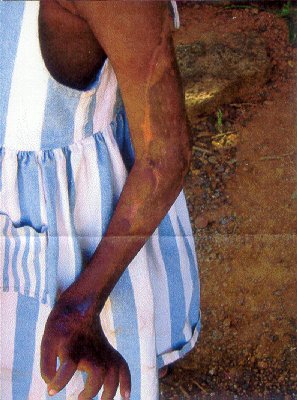
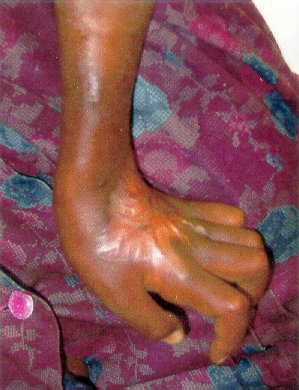
Dr. Elizabeth Meyerhoff-Roberts wrote to me, "... have finally been able to xerox the enclosed photos of Chemandase. She really is well and it was a pleasure to take her home to Pokot ... If I get more contributions I will still try to get her hand straightened, but she can grasp things with her fingers, has an arm, and is alive which is an accomplishment. Please send the people who have made contributions the enclosed 'thank you' flier---and copies of the Chemandase photos if you wish. I really appreciate their help! ..." [Note: The official spelling of the name Chemandazi is not known, hence the variations.]
Here is how you can donate money to Chemandazi, to other patients and to the RAE (Rehabilitation of Arid Environments) project.
The person whose arm you can see at work in some of the pictures above and who runs the small emergency room in Baringo is Dr. Elizabeth Meyerhoff-Roberts.
Have a look at the new web site of RAE Trust
The US address, to which tax-deductible donations can be sent, is:
US, Inc.
RAE Charitable Trust
445 E. Mitchell St.
Petoskey, Michigan 49770-2623
Attn: Ms. Faith Peruzzi or Ms. Nicki Calloway
Tel: (231) 347-1171
Checks should be made out to RAE Charitable Trust.
Dr. Meyerhoff-Roberts writes: If you decide to send a donation to this address, would you mind sending us an email alerting us to that fact. This will simply expedite Chemandazi's treatment.
Addresses and telephone numbers:
Dr. Elizabeth Meyerhoff-Roberts
Social Scientist
RAE Charitable Trust
P.O. Box 1051
Nakuru, Kenya
Tel: +254-37-850864Murray Roberts and Dr. Elizabeth Meyerhoff
PO Box 1051
Nakuru, Kenya
Tel: +254-328-51418
Email: info©raetrust.org – Our phone systems in Kenya cannot handle large documents. Please try not to send attachments. Also when using reply mode please delete the message you are replying to. In other words keep it as short as possible, thank you.

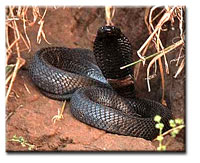
Naja nigricollis, the black spitting cobra
How could the snake bite happen? We don't know for sure. Chemandazi can't say. Some people said it was a spitting cobra, Naja nigricollis, a slim, agile, elegant, jet black reptile that can blind you permanently by spitting poison in your eyes from a distance. It might have been an African cobra, also called forest cobra, Naja melanoleuca, also black-backed, but with a yellow, structured belly, a slow moving, but deadly poisonous snake, or it could have been a puff adder, Bitis arietans, a thick-bodied, extremely venomous African viper that hisses and puffs itself up when threatened, but does not move fast. But it often lashes out violently when approached in defiance of its warning hiss, which is one of the reasons why it is relatively frequently found as the cause of snake bites. If you miss the hissing warning, you can end up like this little patient.
However, the venom of most cobras is a nerve poison that kills by paralysing the prey, causing respiration to stop and the prey to suffocate. But this was obviously another type of venom, a blood poison that attacks the tissue and causes it to disintegrate. The most common culprit of this kind is the puff adder.
The anomaly here is the spitting cobra, which has a blood poison similar to that of vipers and adders. This extremely poisonous snake aims for the eyes in defense and can aim and spit very well over a distance of several meters. The reason for this snake's different poison may well be that a venom that attacks the tissue is the one that works when spat in the eyes.
So it may have been a spitting cobra after all, and the people who suggested this may have been right.
I can only speculate how the snake could bite Chemandazi's hand. Perhaps she stepped on the snake, the snake curled up in defense, but without immediately finding a place to bite. Chemandazi may have felt something and instinctively tried to push it away with her left hand. Perhaps it was at night, when she could not immediately see and recognize the snake.
Another, perhaps more likely explanation is that she groped into a hole in a termite mound, where snakes, particularly cobras, sometimes dwell. In this case her hand may even have been perceived as prey by the snake, leading to a long prey bite involving a large dose of venom into the back of her hand. From there the poison found its way up her arm until much of the upper layer was attacked and denatured.
Then her mother didn't take her to a hospital immediately. Instead she went to a medicine man who tried to heal her by means of a miraculous black stone believed to suck the poison out. That, of course, didn't work well, and the girl's arm deteriorated to its present state. Only then, after more than a week had passed, she sought real help.
It is sad to see how people make their already difficult lives and that of their children worse because they lack basic information and education. One reason for the existence of the various myths about how to treat snake bites is that defensive bites, as opposed to prey bites, even from highly poisonous snakes, are often harmless, because the amount of venom injected is small. A snake biting in self defense, rather than biting to kill prey, is often not in a position and has no intention to apply a prolonged bite and inject large amounts of venom. Even a child is too big for most African snakes to swallow. Most often a human steps on a snake by mistake and the snake then bites to fend off or irritate the human, but its only intention is to get away, not to kill and eat the human. Therefore most of these bites are brief and do not inject a full dose of venom.
This erroneously reinforces false recommendations like the black stone or the many hints at cutting or sucking the wound, which do not hold up against scientific evidence. They often seem to work and therefore provide false positive reinforcement through a misunderstood experience. Trying to suck out the poison can never remove any significant portion of the injected poison. Instead, it can even harm the helper, because some snake poisons in the mouth can cause the throat to sweel and can even lead to suffocation.
The only true hint is that it helps to bind the bitten extremity above the knee or elbow and loosen the tourniquet every 15 to 20 minutes to keep the arm or leg alive. But this makes sense only when the victim has been bitten by a mamba or cobra that injects nerve poison, and when the victim actually shows the typical symptoms. This can help to reduce the effect of the poison on the central nervous system be keeping part of it in the leg or arm for some time. A bite by a black mamba, Dendroaspis polylepis, a green mamba, Dendroaspis angusticeps, or some other mamba can show effects like dizziness, double vision, difficulty to keep the eyes open, or a stiff chest after 10 to 15 minutes already, and it can kill within an hour.
One final remark on snake bites in Kenya. Don't let yourself be detracted from visiting Kenya by this story. I have never heard of any tourist being bitten by a snake. Even among the indigenous people, especially children who run through the bush bare-footed, snake bites are rare. Travellers don't do this, and if they occasionally do, they are more careful, and they don't grope into termite mounds either. If you travel through Kenya, you'll be very lucky to even see a snake. The vast majority of tourists never see one.
My hosts in Baringo have to treat many more burns than snake bites. Apparently petroleum lamps are the real danger here, not snakes.
I finally departed at noon, much later than planned, and drove back to Nairobi in about 6 hours.
Back in the Aero Club I found a box with fresh food, vegetables and fruit, a huge and very heavy cooking gas container and 6 small stools, all of which should go to Amboseli. Purity, the always active secretary of the Langata Link office of the elephant project, had once again showed her ceaseless energy and taken the shopping obligation from my shoulders by doing all the shopping herself and depositing the results in the Aero Club's reception and some more things in my room. There had apparently been a shopping list and a request for me to do the shopping.
I stowed all the stuff into my little jeep, could barely lift up the gas container, but finally managed to stow everything securely away in the back of the jeep. Then I went into the club restaurant for a good portion of tilapia (a tasty sweetwater fish that occurs in the river Nile and in sweetwater lakes such as Lake Victoria) and to continue to write this text.
Later in the evening I walked through the bar where I found the man who maintains the club's aeroplanes, a white Kenyan of British origin. He sat together with some pilots and introduced me to them. While we were chatting, I told them the story of the little girl with the snake bite, and some of them knew which snake has which type of venom, so I could correct the text above accordingly. Later it turned out that they were still wrong, as far as the spitting cobra is concerned, so I had to correct the text once again.
Then they told me that, as sad as the story of the little girl may be, it is still incomparable to the horrors they regularly witness when they make relief flights into southern Sudan, usually from Lokichoggio, a place with an airfield in northern Kenya, not far from the Sudanese border.
This wretched part of the world is engulfed in a never-ending war between the muslim north and the christian south. Both sides fight with a brutality and commit atrocities that are never reported by any media, possibly because the first to show the truth would be accused of false reporting, racism and violating all acts to protect young viewers.
They told me about how people have given up planting their fields, because doing so would only lead to the soldiers burning everything down again. They told me about flying into towns that had just been conquered by the other side, with hundreds, sometimes thousands of dead and wounded, about how they sort the survivors into "green lights" and "red lights", depending on the chance of their survival, then how they go in and out of the place for days, every time shuttling a planeload of wounded, bleeding people to a hospital. They told me how, in spite of the selection, some people still die in the plane, about the routine of silently covering them with a blanket. They mentioned that the Sudanese usually suffer in silence, without speaking a word. One once picked up a starved boy and tried to hold him in her arms, then lifting his legs with her other arm. When she lifted him up, he suddenly whimpered, so she went looking for the cause. It turned out he was shot through the pelvis, yet he never showed any signs of pain, so the injury had gone unnoticed until he was picked up.
They told me the story of the heavily pregnant woman with a shot right through her belly who gave birth in the plane to a child. But the child had the shot going right through its chest and was dead. The shot had killed the child in the mother's womb.
They wrapped the child's corpse like a mummy and gave it to her, and she never said a word and never gave off a sound of grief. And they told me how she then, still in the flying aeroplane, gave birth to a twin of the dead one, who lived and was healthy. This was the first time they heard anything from her, a sound of joy. They quietly took the dead child away from her.
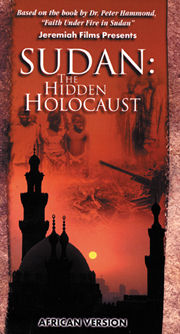 They
told me about roads and sometimes even runways lined with heads that had been cut
off from the losers of recent battles, of soldiers riding into enemy towns, shooting
all the men, then taking women and children as slaves to sell to Arabia. Of children
chained to heavy weights, so they would not again try to escape. This is the background
to the reports of small bands of children reaching Egypt after fleeing on foot through
the hot desert. Only a tiny proportion makes it, and these are only young boys.
Most die on the way. Some get caught and end up as slaves again.
They
told me about roads and sometimes even runways lined with heads that had been cut
off from the losers of recent battles, of soldiers riding into enemy towns, shooting
all the men, then taking women and children as slaves to sell to Arabia. Of children
chained to heavy weights, so they would not again try to escape. This is the background
to the reports of small bands of children reaching Egypt after fleeing on foot through
the hot desert. Only a tiny proportion makes it, and these are only young boys.
Most die on the way. Some get caught and end up as slaves again.
And they told me about a video named "Sudan: The Hidden Holocaust", that is known and seen only by insiders. It contains footage taken from hidden cameras in southern Sudan. People had given the presumed victims of future assaults video cameras, so some of the untold truths are now at least told to a few.
It shows children being whipped as they refuse to read the Quran, a man beating a child with a chain until the child dies, then carrying on beating the dead child. It shows two men riding a horse into a village, the second one sitting backwards, shooting all people on sight. It shows a soldier throwing a baby into the air and catching it with his bayonet.
Pensively I go to bed around midnight and cannot sleep for a long time.
Addendum 2002-07-20: I just ordered the VHS video, "Sudan: The Hidden Holocaust" from the Persecution Project Foundation (PPF, www.persecutionproject.org). Unlike the Frontline Fellowship (www.frontline.org.za) they accept credit card payment through email. Be sure to specify PAL (Europe) or NTSC (America) format when you order. No other formats, like video CD or DVD, are available, unfortunately.
I woke up early in the morning anyway and considered to leave right now, driving into the rising sun. But I was still tired, and some time went by. Later I might as well have a light breakfast in the club restaurant and visit the Internet café on my way out, to upload this text. So I stayed in bed for a little while longer, listening to the sounds of the first few aeroplanes taking off.
This time I would not again take the long, dusty road through Mashuru, Osilalei and Lenkisim. With the heavy load in the back of the jeep I would go through Athi River, Kajiado and Namanga, a border town to Tanzania.

A sign next to the Mombasa Road
Ah, the Mombasa Road again! One of the busiest roads in the country, it has its peculiar flair of the main traffic artery to the coast, of long distance travel, but also of danger and a high accident rate, of dangerous drivers, risky overtaking maneuvers and the unexpected deep cut into the edge of the pavement at the very moment when you can least deal with it.
I left the Mombasa Road in Athi River and turned onto the road to Kajiado, Bissil and Namanga.
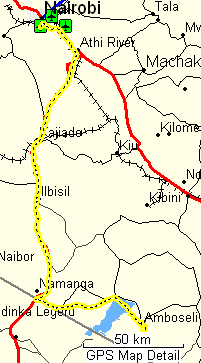
Just before the the actual border I turned left onto the sandy track towards Amboseli that winds its way through an endless row of small trading shacks. I bought a few more cabbages and other vegetables to complement Purity's choice of tasty fruits and went on my way to Amboseli. I chose the second route that winds its way through Maasai villages, avoids the corrugated main road to Meshenani gate and leads back that road only very shortly before the gate. I needed to go to that gate again to get another smart card and pay the entrance fee to Amboseli National Park, so the faster third route to Kitirua Gate is unsuitable.

Driving through Maasai country
The road turned out to be good, but even more dusty than the one I had taken before. Unfortunately the small Suzuki jeep has the habit of sucking in dust from somewhere underneath the car, so even though one drives in clean air and has the windows open, the dust still comes in from below. I could not find out where it actually enters the car, but I couldn't change that anyway.
At one place I drove into a bowl filled with powder dust, which splashed up like water, so I couldn't see anything. I slammed on the brakes and came to a halt in a huge cloud of dust that also came in through the open windows. I waited for the dust to settle, but still couldn't see a thing. I had to switch on the windshield wipers, and that helped. The windshield had been covered by a whole layer of dust that needed to be wiped away before I could see again.
I stopped at the gate to get yet another smart card, and the people there recognized me. They had earlier asked me about my luggage, and I had somehow mentioned the movies. Now they asked me again about the computer and the movies, and I decided to show them a strongly abbreviated version of Titanic. They liked it. And for me it's possibly not too bad to be friends with the people at the gate.
Then I drove on towards Ol Tukai through Lake Amboseli. Driving along the perfectly flat lake bed, I saw a fata morgana in front of me that looked like a real lake, and a huge one. Another car approaching me appeared to float on it like a boat. Only after it came much closer, I could really recognize it as a car.
Eventually I arrived in the research camp and the people there, after looking at me, immediately offered me a shower, which I gladly accepted.
Initially the plan was to solve a few more computer and GPS problems, mostly by teaching. But after breakfast a call came in that there was a sick elephant bull with a spear wound in is left foreleg that apparently got infected. He could hardly walk and should be treated.
So we go out to meet up with the veterinarian, Dr. S., a woman of Indian origin, and the rangers at the place where the bull had last been seen. After about half an hour's searching we find him, standing between bushes and trees. We can see the wound in his leg. A Maasai spear had hit him and gone in deeply. He did, of course, pull out the spear, but the wound got worse nonetheless.
He is one of the Kilimanjaro elephants that sometimes wander over into Kenya. About 25 years old, he is already bigger than any female, but bulls of this age are still too young, too small, too inexperienced to mate.
The veterinarian prepares the dart with the rather poisonous drug with the innocuous-sounding name "M99". When I ask her something, she replies that she prefers not to speak while handling M99, and I learn that even small amounts can be lethal to humans. She handles the drug without wearing gloves.
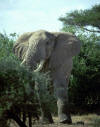
The dart went into his left foreleg
Then she shoots the dart into his swollen foreleg near the shoulder. The elephant bull reacts a little bit, but remains standing. After a few minutes he reaches for the dart and pulls it out. I later ask the vet about the release time of the dart, and she explains that the dart releases its entire load instantly, within about a second. The reason for this is that elephants often pull out the dart, so the short time makes sure that this does not prevent the desired effect.
However, the elephant does not fall asleep within the expected 5 to 10 minutes. We are about to give up, because the vet doesn't have another full dose with her, when, after about 45 minutes, the elephant finally shows clear signs of swaggering. The vet decides to dart him again with the small amount of M99 she still has.
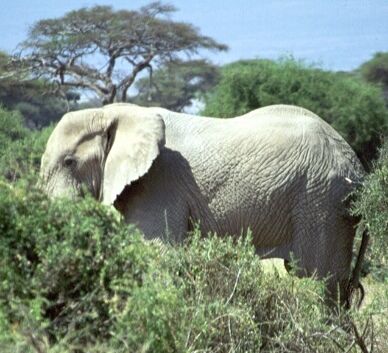
The second dart
This time the dart goes into the elephant's rear. But the bull still doesn't fall over. He struggles hard to remain standing, even though the drug has a quite visible effect. He swaggers, leans far backward, then time and again pulls himself back up. He then leans backward against a bush and slowly pushes himself rearward into the bush. Minute after minute elapses, yet the elephant is still struggling to remain on his feet. He has now moved backward through the entire bush and comes out on the other side.
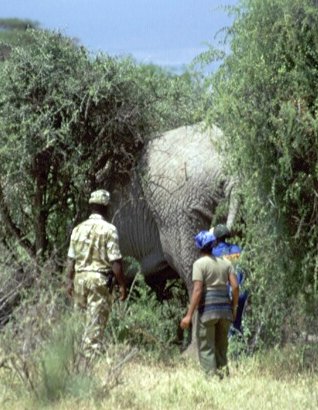
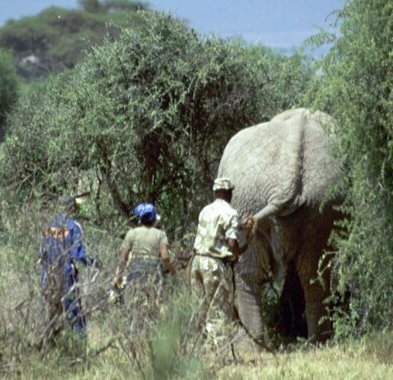
Trying to stay upright
The rangers have meanwhile walked up to the elephant and begin to pull on his tail and try to throw a rope through his legs to pull him down. That doesn't work, but after a seemingly endless time the elephant sits down, rather than rolling over on his side.
Sitting isn't very good for elephants, because it makes breathing difficult, so they throw a rope over the elephant and pull it around his neck. He is still trying to stay awake, and we should better not get into the reach of his trunk. Everybody pulls, but the elephant spreads his forelegs such that we cannot pull him over on his right side.
Two times the rangers tie the rope to their jeep and pull, but both times the rope breaks. But eventually the elephant gets so close to sleeping that he begins to lean to the right side on his own. Standing right in front of him, I notice this and shout, "Pull, pull, he's rolling!" So they pull one last time, and the elephant finally rolls over and now lies on his right side.
They immediately begin with the treatment. A stick is put in his trunk tip to keep his nose open.
The vet begins to give him injections and treat the open wound. Somebody pours water over the elephant's ear and head to cool him. Some drug is squirted into his eyes.



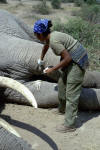
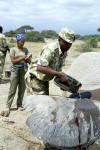
Treatment and keeping him cool with water
After a few more minutes the work is finished, and the vet gives him the final wake-up injection (M5050) into a vein in his ear. Everybody moves back to the jeeps immediately, and indeed after about two minutes the elephant quickly rises to his legs. He keeps standing in the same place without moving.
For a while we try to scare him into walking into the shade of a nearby tree, but he stubbornly keeps his position. Only after some time of waiting does he let himself be directed towards the tree, and eventually he limps over and stands in the shade.
We leave him alone and go back. Nora, who drives the research jeep, takes us along to allow us to see her normal observation work. We visit several groups of elephants, among them an apparently estrous female with her small calf who is surrounded by five big bulls, the biggest one in musth. We cannot find out whether they have already mated and the bull is just protecting her from being mated again by somebody else or whether the time has not yet come. Nora explains that the family group usually stays with an estrous female, but when there is too much chasing and stress, they give up and let her go away on her own with the bulls. Only her young calf will not leave her.
I later hear that the other observers saw one mating.
Other family groups allow us to drive very close to them, and even then the elephants walk up to about 3 m from the car to greet us. The Amboseli elephants are unbelievably friendly, especially towards the research jeeps which they know well.
Nora collects several dung samples for the ongoing DNA study, then we go back to camp for lunch. The others were already there and had already eaten, so we sat down outside the dinner tent with them and ate the rest.
In the afternoon I swapped an old solar battery for a new one and repaired a solar controller that had gone bad. This required driving over to the baboon camp, because we don't have any soldering equipment here. Unfortunately, they also had insufficient materials there. The solder didn't have the usual colophonium core, and they didn't have either colophonium or anything like soldering fat.
So I tried to repair the bad contacts by scratching them clean, then scratching them with the soldering iron, and that probably didn't work very well. But the contacts seemed to hold, and there was nothing more I could do. So I thanked the people there and drove back to camp to install the repaired solar controller, which is there to prevent overcharging the lead acid batteries.
Finally I sat down in front of my tent to write this text in the evening sun while looking at Kilimanjaro whose cloud collar had slowly dissolved as the sun sank lower. A herd of zebras grazes in front of me on the open grass area next to the camp.
P. and S. prepare the dinner, and I look forward to meeting all the people, who have driven out to see the animals, again in the dinner tent.
This morning the head of the project flies back to Nairobi. Some of the people from the camp and research house including me take her to the airfield where she boards a Dash-7 aircraft operated by Air Kenya on its regular flight to Nairobi.
After this I go back to the research house to answer a couple of new computer-related questions and solve a few minor problems related to mapping and the display of GPS data on electronic maps.
Then I drive back to the research camp and begin to work on a problem with the short wave radio in one jeep. I swap the radio with the fixed one in the camp, which is of the same type, to see whether the defect is in the radio itself or, more likely, in the aerial or its cable. Since the defect is intermittent, it will take a little time to find out.
The rest of the morning I can now be lazy. The mountain has been out of the clouds throughout the morning, but now, as the temperatures rise, the clouds cover it up as they mostly do.
The two remaining researchers come back to the camp for lunch, and I plan the last little bit of my stay. As my stay in Amboseli has been delayed by one day already, it now makes no sense for me to go to Nairobi, only to have to waste the last day of my vacation there. So I decide that the best thing to do is to stay in Amboseli until the very end.
This would also suit P. very nicely, as he had planned to go to Sultan Hamud to formalize his marriage of 26 years. Sultan Hamud is a town at the Mombasa Road, so he could alight at Athi River, then take a bus or matatu the short distance down to Sultan Hamud.
In the afternoon of this very clear day only the mountain was surrounded by clouds, but I could already see the corner of the snow-covered top, so I dedided to go out again to watch the wildlife and perhaps take a few more photographs. I took S. with me, who is an avid bird watcher, certainly good enough to be a guide and earn some money that way, but Amboseli is, quite unjustifiedly, not known for its wealth of bird species. Those tourists who come to Kenya specifically for bird watching usually go to places like Baringo.
We drove out to the south, then turned west towards the swamp and drove along the swamp edge. On this route we already saw quite a few interesting birds, among them a pair of white-bellied bustards with their gentle, slow movements as they stalk their prey, and later the much bigger Kori bustard.
We then crossed over the Sinet causeway, a dam cutting right through the swamp, and drove around a little on the other side. By then it was already 6 pm, half an hour before sunset, so we turned around and slowly began to make our way back to the camp.
I drove very slowly across the causeway again while looking for water birds like herons and egrets, when S. suddenly signaled me to stop. He was looking out the left window and looked down into the swamp. I crept over to that side and saw what had drawn his attention—a cat that looks almost like a domesticated cat, except that it is at least two times as big and looks more slender and elegant, especially with its big, agile ears that are proportionally even bigger than those of a domestic cat. Its tail is proportionally somewhat shorter, though by far not as short as that of a lynx. Its color was grey with black spots. The normal color of a serval cat is yellowish, with a touch into light brown, and dark spots, but this one could just be dirty from the swamp or the dust.
The cat is visibly worried about the car and the two faces staring at him. He looks at us and eventually sneakily turns around, perhaps to be able to flee faster. Even the slightest noise we make immediately makes his ears point straight towards us.
We stay there for a while, admiring the elegance of this animal, then we slowly continue across the swamp and drive home to the camp.
In the morning the sky is totally overcast, but after breakfast the clouds disappear and the mountain comes out in all its glory. So I jump into the jeep and drive out for some more observation and photographs.

Wildebeest (gnu) in front of Kilimanjaro
On my way back I find a dead zebra next to the west entrance to Ol Tukai that has apparently been hit by a car driven by some reckless driver. I drive back to the research camp for lunch and call park headquarters to tell them about the zebra. They will come and take it away, because they know that this is not what the tourists want to see.
After lunch I finally get to writing and proofreading this text, then I see that the mountain is again coming out of the clouds, and I drive out to the swamp in the north of Ol Tukai and take photos of elephants and other animals with the mountain in the background.
Later I use the sunset as background, as there are almost no clouds, and the sun is setting as a red glowing disk.
In the last light of dusk I arrive back at the camp and look forward to a tasty dinner with the two researchers.
Early in the morning, as usual, there is some breakfast, again with the two researchers who will, apart from the permanent employees, be the sole inhabitants of the research camp most of the time. Then S. and I say goodbye to everyone, jump in the car and drive off.
We pass by the research house and say goodbye to Soila as well, then we set off and drive past the airfield and through Lake Amboseli to Meshenani Gate, where I have to pay for the yet unpaid days in the nature reserve.
After greeting the rangers and smart card handling personnel, paying my dues and flirting with the only female ranger in the bunch we drive through the gate for the last time this year. 5 km later we turn off the main road and drive on the very dusty, but shorter and smoother track through Maasai land, past many manyattas (small settlements) and into S.'s home area.
There he drops off, and I continue towards Namanga. On the way I pick up a hitch hiker who first says he wants to get to Namanga, then extends to Bissil where he wants to visit his grandparents.
After some two hours we reach the border town Namanga, turn onto the paved road and drive towards Bissil, Kajiado and Athi River.
My guest drops off at Bissil, and I continue through Kajiado and eventually Athi River, where I enter the Mombasa Road for the last time (apart from the very last time when I will go to the international airport, which also requires going along the first, four-lane bit of the Mombasa Road).
Extremely slow driving trucks make this a less than thrilling experience, but it is not far to Nairobi, and after another two hours I enter Wilson Airport and reach the Aero Club, where I will spend my last night.
I had contacted my friend, the anthropologist, through her hosts by email from Amboseli, and they had invited me for dinner tonight, which I gladly accepted. I cannot find any better way to spend my last evening in Nairobi.
My only worry is to get car-jacked and robbed while driving back to the Aero Club through Nairobi late at night, but I will leave all valuables in the club and will not even take my flight ticket with me, just in case. It is difficult to assess the risk. I think it is small if I don't stop anywhere. It is just not easy to attack a car while it moves, and I will be driving along major roads only.
The evening turned out to be very interesting. We discussed at length the question whether, to what extent, and for how long culture can be a hindrance to progress and adaptation. The anthropologist thinks not much, some others, including myself, tend to think that it can be a hindrance and that it can take generations to overcome cultural maladaptation. The anthropologist really should know, and I will have to rethink my stance.
Late at night I did drive back right across Nairobi, from the far north to the far south, and nothing happened. I even filled the tank at a petrol station in Westlands, which is not considered a particularly safe area. But then we always have the small risk phenomenon, the fact that you don't get attacked every day and that it is difficult to assess the actual risk. My hosts, for example, refuse to budge and regularly drive through Nairobi at night when they have any good reason to do so.
I came back to the Aero Club at midnight and saw the bar crew close the bar, just as I wanted to buy one last little bit of chocolate. So I went to bed and slept around ¾ of an hour past midnight.
My watch woke me up at 6 am. I packed my things, put them in the jeep and drove off without breakfast. I was a bit afraid that I could be knocked off the flight if it is overbooked, which is not a rare occasion around here. It has happened to me before (with Air France).
I arrived there at 7 am, 3 hours before departure. My immediate problem was to return the jeep without having to walk all across the airport with all my luggage. But the African lady at the Hertz counter, who meanwhile knows me well and is always good for a little chat, just whistled for a driver whom she knew and who was hanging out in the arrivals hall. I put him in the driver's seat to check whether he would have any difficulties to drive the Suzuki, but he had none. So we drove over to terminal 2, he dropped me off there and took the jeep back to the parking lot after getting a tip from me.
The departure was uneventful. Nairobi International Airport is being reconstructed, but with the little traffic it gets these days there was no problem with that either.
The KLM flight was actually operated by Kenya Airways. (Oh, the wonders of code sharing!) The Boeing 767 is a very comfortable aeroplane, and I could watch two new movies on my personal entertainment system ("A Brilliant Mind" and "Gosford Park", both of which will probably get a B rating from me). With Gosford Park I had the choice of either French or English with Arabic subtitles. Had to choose the latter. In this respect Kenya Airways ("The pride of Africa", as they call themselves in their own advertizing) clearly beats KLM. One can only hope that their accident record also remains good.
The food was reasonably good and the cabin crew friendly—I have no complaints. They officially announce the rule that no electronic equipment may be operated during the flight except after obtaining approval from the crew, but when asked they always allow everything except mobile phones. So I could pull out my GPS and see and record where we flew.
The flight went quite far to the west, not touching Egypt and bypassing Khartoum far to the west, which is unusual. The plane crossed the short common border from the Sudan to Libya, then went over the Mediterranean some way to the west of Benghazi. We flew past Malta, across the western part of Sicily, past Sardinia and Corsica, then entered the core of Europe near Genova and continued to Amsterdam via Luxembourg.
I am writing this on the Amsterdam airport (Schiphol) on a little Internet communication zone, of which there are several around here, but I'm actually only using the electricity socket for free. I will upload this text later tonight, if I don't fall asleep before getting to it.
I'm back home. The good time in Africa is over. But there will be another time and most likely another travel report.
Altogether it was a new experience to have the computer with email and the mobile phone with me deep down in Africa.
A big surprise was my mobile phone bill. I expected something rather high, but it turned out to be all of €6.87. It seems that either KenCell or Safaricom, the two Kenyan service providers, actually made a mistake and didn't bill me for at least one call. The SMS messages were very cheap (€0.10 for KenCell, €0.26 for Safaricom), and the telephone calls inside Kenya are cheaper than those to or from back home. KenCell is generally much cheaper for anything, usually less than half, but Safaricom has better coverage, so you end up using mostly Safaricom.
Anyway, it seems that technological progress is now so fast that there is some new and useful gadget almost every year. Another one this year was the high-tech LED flashlight, a tiny lamp that is about as bright as the much bigger ones I used in earlier years, but runs on 3 LR-44 button cells for many hours.
But all this is secondary to the experience of Africa.
The following photographs are from last year. Beginning next year I will take photos digitally, and perhaps that will make it possible for you to see the journey develop in near-real-time.

Our Suzuki Sierra jeep, on the road for a whole day from Baringo to Samburu
![]()
Our Cessna 182 landing at Samburu (after chasing zebras from the runway)
The grinning pilot is me.
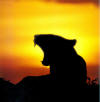
Lioness in front of the evening sun
Photo copyright © 2001 Thomas R. Wilke
If you find typos, orthographic errors (even small ones), ungrammatical sentences, wrong or illogical information in this text, or if you want me to write more details about something in particular, please click on the email sign below and write to me. Many thanks!
Copyright © 2002-2023 Hans-Georg Michna.
Private homepage – Hans-Georg Michna
Kenya travel reports: 1999, 2000, 2002, 2003, 2004, 2005, 2006, 2007, 2008, 2009, 2010, 2011, 2012, 2013-Goma, 2013, 2014, 2015, 2016, 2017, 2018, 2019
Kenya Safari Travel Plan, Kenya 1980-2000 photos
hits since 2007-11-01
Free PHP scripts by PHPJunkYard.com